सम्प्राप्तिः
(Pathogenesis according to Madhava-Nidanam)
क्रमांक |
रोगाणां तालिका |
अध्यायाः |
उपलब्ध-सम्प्राप्तिः |
सन्दर्भ-श्लोक-संख्या |
1. |
अतिसार-निदानम् |
a |
1-5 |
|
2. |
विद्रधि-निदानम् |
a |
11,14-16 |
|
3. |
वृद्धि-निदानम् |
a |
7-10 |
|
4. |
हिक्काश्वास-निदानम् |
a |
6 |
|
5. |
वातव्याधि-निदानम् |
a |
28-30 |
|
6. |
अपस्मार-निदानम् |
a |
1 |
|
7. |
ज्वर-निदानम् |
a |
26 (1-4) |
|
8. |
अभ्यन्तरायामः-निदानम् |
a |
1-2 |
|
9. |
अम्लपित्त-निदानम् |
a |
1-2 |
|
10. |
वातव्याधि-निदानम् |
a |
44-46 |
|
11. |
गलगण्डगण्डमालऽप-चीग्रन्थ्यर्बुद-निदानम् |
a |
18-19 |
|
12. |
अर्श-निदानम् |
a |
2 |
|
13. |
वातव्याधि-निदानम् |
a |
65 |
|
14. |
अश्मरी-निदानम् |
a |
2,4-6 |
|
15. |
मूत्राघात-निदानम् |
a |
4 |
|
16. |
वातव्याधि-निदानम् |
a |
27 |
|
17. |
उदावर्तानाह-निदानम् |
a |
17 |
|
18. |
आमवात-निदानम् |
a |
1-6 |
|
19. |
अतिसार-निदानम् |
a |
11 |
|
20. |
क्षुद्ररोग-निदानम् |
a |
28-29 |
|
21. |
उदर-निदानम् |
a |
1-4 |
|
22. |
उन्माद-निदानम् |
a |
4-6 |
|
23. |
मूत्राघात-निदानम् |
a |
15-17 |
|
24. |
ऊरुस्तम्भ-निदानम् |
a |
1-5 |
|
25. |
कर्णरोग-निदानम् |
a |
1 |
|
26. |
पाण्डुरोगकामलाकुम्भ-कामलादि- निदानम् |
a |
16-18 |
|
27. |
कास-निदानम् |
a |
1-2 |
|
28. |
कुष्ट-निदानम् |
a |
1-6, 23-25 |
|
29. |
कास-निदानम् |
a |
12-13 |
|
30. |
वातव्याधि-निदानम् |
a |
59 |
|
31. |
गलगण्डगण्डमाला-ऽपचीग्रन्थ्यर्बुदनिदानम् |
a |
2 |
|
32. |
गलगण्डगण्डमाला-ऽपचीग्रन्थ्यर्बुदनिदानम् |
a |
11 |
|
33. |
ग्रहणी- निदानम् |
a |
1-3 |
|
34. |
नेत्ररोग-निदानम् |
a |
71-73 |
|
35. |
अर्श- निदानम् |
a |
43-44 |
|
36. |
छर्दि-निदानम् |
a |
2-4 |
|
37. |
वातव्याधि-निदानम् |
a |
52 |
|
38. |
ज्वर-निदानम् |
a |
2-3 |
|
39. |
हिक्काश्वास-निदानम् |
a |
27-34 |
|
40. |
तृष्णा-निदानम् |
a |
1 |
|
41. |
वातव्याधि-निदानम् |
a |
32-33 |
|
42. |
नाडीव्रण- निदानम् |
a |
1 |
|
43. |
नेत्ररोग-निदानम् |
a |
92 |
|
44. |
वातव्याधि-निदानम् |
a |
39-41 |
|
46. |
शुलपरिणामशूलान्नद्रवशूल - निदानम् |
a |
15-21 |
|
47. |
क्षुद्ररोग-निदानम् |
a |
41-42 |
|
48. |
क्षुद्ररोग-निदानम् |
a |
32 |
|
49. |
नासारोगनिदानम् |
a |
2 |
|
50. |
नासारोग-निदानम् |
a |
13-14 |
|
51. |
नासारोग-निदानम् |
a |
9 |
|
52. |
प्रमेह-निदानम् |
a |
1-3,6 |
|
53. |
कर्णरोग-निदानम् |
a |
3 |
|
54. |
वातव्याधि-निदानम् |
a |
36 |
|
55. |
मसूरिका-निदानम् |
a |
1-2 |
|
56. |
वातव्याधि-निदानम् |
a |
65 |
|
57. |
मूत्रकृच्छ्र-निदानम् |
a |
1-2 |
|
58. |
मूत्राघात-निदानम् |
a |
12 |
|
59. |
मूत्राघात-निदानम् |
a |
8-9 |
|
60. |
मूत्राघात-निदानम् |
a |
14 |
|
61. |
मूत्राघात-निदानम् |
a |
17-19 |
|
62. |
मूत्राघात-निदानम् |
a |
10-11 |
|
63. |
मूर्च्छाभ्रमनिद्रातन्द्रा- संन्यास-निदानम् |
a |
1-4,19 |
|
64. |
पाण्डुरोगकामला-कुम्भकामलादिनिदानम् |
a |
8-11 |
|
65. |
मेदोरोग-निदानम् |
a |
1-4 |
|
66. |
गुल्म- निदानम् |
a |
15-16 |
|
67. |
रक्तपित्त- निदानम् |
a |
1-3 |
|
68. |
राजयक्ष्माक्षतक्षीण-निदानम् |
a |
1-2, 5-7 |
|
69. |
मूत्राघात-निदानम् |
a |
21-26 |
|
70. |
मूत्राघात-निदानम् |
a |
2-3 |
|
71. |
मूत्राघात-निदानम् |
a |
5-6 |
|
72. |
वातव्याधि-निदानम् |
a |
1-4, 6-8 |
|
73. |
मूत्राघात-निदानम् |
a |
19-20 |
|
74. |
विद्रधि-निदानम् |
a |
1-3 |
|
75. |
अग्निमान्द्यादि-निदानम् |
*a |
21 |
|
76. |
ज्वर-निदानम् |
a |
31,33,36 |
|
77. |
विसर्प-निदानम् |
a |
1,4 |
|
78. |
विस्फोट -निदानम् |
a |
1-2 |
|
79. |
वृद्धि-निदानम् |
a |
1-2 |
|
80. |
क्षुद्ररोग-निदानम् |
a |
39 |
|
81. |
क्षुद्ररोग-निदानम् |
a |
22-24 |
|
82. |
शीतपित्तोदर्दकोठ-निदानम् |
a |
1,4-5 |
|
83. |
अतिसार-निदानम् |
a |
9-10 |
|
84. |
शोथ-निदानम् |
a |
1, 3-6 |
|
85. |
हिक्काश्वास-निदानम् |
a |
17 |
|
86. |
मूर्च्छाभ्रमनिद्रातन्द्रा- संन्यासनिदानम् |
a |
22,23 |
|
87. |
क्षुद्ररोग-निदानम् |
a |
48-49 |
|
88. |
गलगण्डगण्डमालाऽप- चीग्रन्थ्यर्बुदनिदानम् |
a |
16-17 |
|
89. |
स्तनरोग -निदानम् |
a |
1-2 |
|
90. |
स्वरभेद-निदानम् |
a |
1 |
|
91. |
वातव्याधि-निदानम् |
a |
49-50 |
|
92. |
हृद्रोग-निदानम् |
a |
1-2 |
1. अतिसारः (Atīsāraḥ)
The text :
संशम्यापां धातुरग्निं प्रवृद्धः शकृन्मिश्रो वायुनाऽधः प्रणुन्नः।
सरत्यतीवातिसारं तमाहु-र्व्याधिं घोरं षड्विधं तं वदन्ति॥ (अतिसारनिदानम्/ ४ )
Easy Sanskrit meaning (anvaya)- प्रवृद्धः अपां धातु: अग्निं संशम्य शकृन्मिश्रः वायुना प्रणुन्नः अध: अतीव सरति, (अत: विद्धांस:) तं घोरं व्याधिम् अतिसारम् आहुः ।
English meaning : Increased apa-dhātu of the body subduing the internal digestive fire, mixing with the faeces, and being pushed down by vāyu flows out excessively; that serious disease is called atisāra (by the scholars).
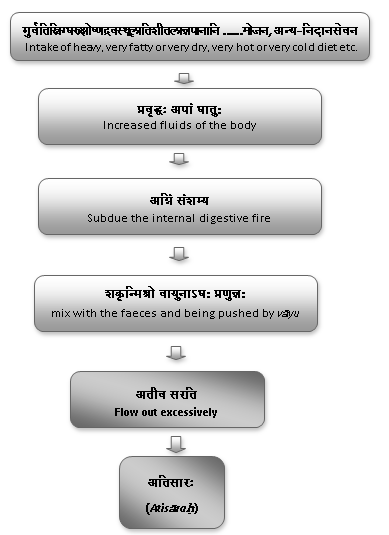
2. अन्तःविद्रधिः (Antaḥvidradhiḥ)
The text :
पृथक् सम्भूय वा दोषाः कुपिता गुल्मरूपिणम्॥
वल्मीकवत् समुन्नद्धमन्तः कुर्वन्ति विद्रधिम्॥ (विद्रधिनिदानम् /११)
Easy Sanskrit meaning (anvaya)- कुपिता: दोषा: पृथक् संभूय वा अन्त: गुल्मरूपिणं वल्मीकवत् समुन्नद्धं विद्रधिं कुर्वन्ति।
English meaning:
The vitiated doṣāḥ, separately or in combination, produce a gulma (bush-like swelling) like internal abscess which resembles an elevated anthill.
Flow chart-
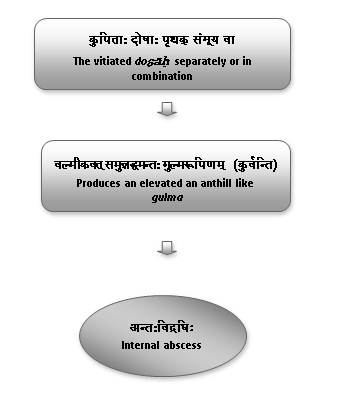
3. अन्त्रवृद्धिः (Antravṛddhiḥ)
The text
वातकोपिभिराहारैः शीततोयावगाहनैः॥ धारणेरण-भाराध्व-विषमाङ्गप्रवर्तनैः।
क्षोभणैः क्षोभितोऽन्यैश्च क्षुद्रान्त्रावयवं यदा॥पवनो विगुणीकृत्य स्वनिवेशादधो नयेत्।
कुर्याद्वङ्क्षणसन्धिस्थो ग्रन्थ्याभं श्वयथुं तदा॥ (वृद्धिनिदानम् /७-१०)
Easy Sanskrit meaning (anvaya)-
वातकोपिभि: आहारैः, शीततोयावगाहनैः,धारणेरणभाराध्वविषमाङ्गप्रवर्तनैः, अन्यै: क्षोभणैः च क्षोभित: पवन: यदा क्षुद्रान्त्रावयवं विगुणीकृत्य स्वनिवेशाद् अध: नयेत्, तदा वङ्क्षणसन्धिस्थ: ग्रन्थ्याभं श्वयथुं कुर्यात्।
English meaning: Vāyu, vitiated by vāta-vitiated foods, immersions in cold water, suppression of urges, carrying heavy weight, improper physical activities, when deforming the kṣudrāntra (small intestine) and pushing to the downwards direction from their original location and produces knot like swelling in vaṅkṣaṇasandhi (inguinal region).
Flow chart-
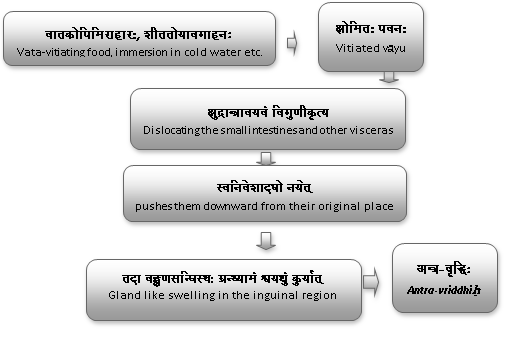
4. अन्नजाहिक्का (Annajāhikkā)
The text
पानान्नैरतिसंयुक्तैः सहसा पीडितोऽनिलः।
हिक्कयत्यूर्ध्वगो भूत्वा तां विद्यादन्नजां भिषक्॥ (हिक्काश्वासनिदानम् /६)
Easy Sanskrit meaning (anvaya)- अतिसंयुक्तैः पानान्नै: सहसा पीडित: अनिलः उर्ध्वग: भूत्वा हिक्कयति, तां भिषक् अन्नजां विद्यात् ।
English meaning :
Excessive intake of food and drinks suddenly aggravate vāyu which inturn moving upwards produces hiccough; the bhiṣag (the physician) considers this as annaja(hikkā).
Flow chart-
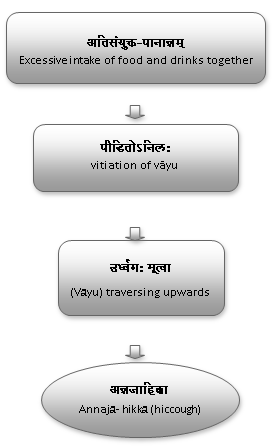
5. अपतन्त्रकः (Apatantrakaḥ)
The text
क्रुद्धः स्वै कोपनैर्वायुः स्थानादूर्ध्वं प्रवर्तते॥ पीडयन् हृदयं गत्वा शिरः शङ्खौ च पीडयन्।
धनुर्वन्नमयेद्गात्राण्याक्षिपेन्मोहयेत्तदा॥ स कृच्छ्रादुच्छ्वसेच्चापि स्तब्धाक्षोऽथ निमीलकः।
कपोत इव कूजेच्च निःसंज्ञः च सोऽपतन्त्रकः॥ (वातव्याधि-निदानम्/२८-३० )
Easy Sanskrit meaning (anvaya)-
स्वै: कोपनै: क्रुद्धः वायुः, स्थानाद् ऊर्ध्वं प्रवर्तते, गत्वा हृदयं पीडयन् शिरः शङ्खौ च पीडयन् तदा गात्राणि धनुर्वद्-नमयेत् आक्षिपेत् मोहयेत् तदा (च)। स: कृच्छ्रात् उच्छ्वसेत् अथ स्तब्धाक्ष: निमीलकः च, निःसंज्ञः कपोत: इव कूजेत् स: अपतन्त्रकः (कथ्यते)।
English meaning :
Vāyu, aggravated by its specific vitiating factors, traverses upwards from its own site and reaching (the śiraḥ) it involves the śiraḥ (head) , hṛdaya, śaṅkha (temporal regions) and thereafter bends the body like a bow, and produces ākṣepa (convulsions) and moha (fainting); he breathes with great difficulty with his eyes fixed or with twitching movements of the eyelids and coos like a pigeon in an unconscious state. The condition is called apatantrakaḥ.
Flow chart-
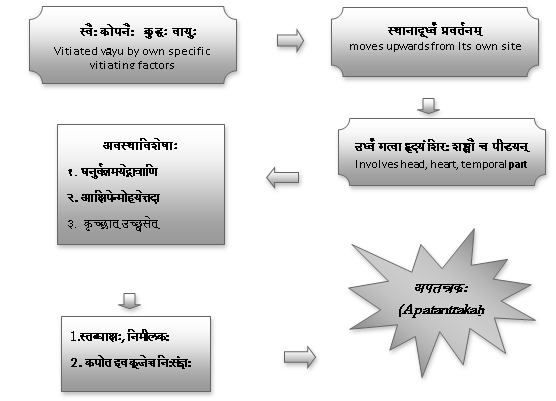
6. अपस्मारः (Apasmāraḥ)
The text
चिन्ता-शोकादिभिर्दोषाः क्रुद्धा हृत्स्रोतसि स्थिताः।
कृत्वा स्मृतेरपध्वंसमपस्मारं प्रकुर्वते॥ (अपस्मार-निदानम्/१ )
Easy Sanskrit meaning (anvaya)-
चिन्ताशोकादिभि: क्रुद्धा: दोषाः, हृत्स्रोतसि स्थिताः।(ते) स्मृते: अपध्वंसं कृत्वा अपस्मारं प्रकुर्वते।
English meaning :
Doṣāḥ aggravated on account of anxiety, grief etc get inlodged in the channels of hṛdaya and causing the loss of memory produce apasmāraḥ.
Flow chart-
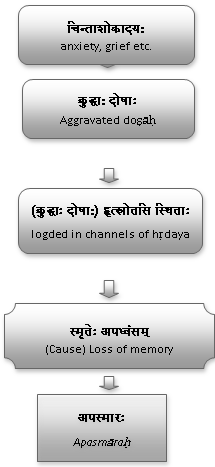
7. अभिन्यासज्वरः (Abhinyāsajvaraḥ)
The text
त्रयः प्रकुपिता दोषा उरःस्रोतोऽनुगामिनः। आमाभिवृद्ध्या ग्रथिता बुद्धीन्द्रियमनोगताः॥
जनयन्ति महाघोरमभिन्यासं ज्वरं दृढम्। (ज्वरनिदानम् 26 (1-4))
Easy Sanskrit meaning (anvaya)-
प्रकुपिताः त्रयः दोषाः उरःस्रोतोऽनुगामिनः, बुद्धीन्द्रियमनोगताः आमाभिवृद्ध्या ग्रथिता (सन्) महाघोरं दृढम् अभिन्यासं ज्वरं जनयन्ति |
English meaning :
Aggravated three doṣāḥ, following the channels of uraḥ, getting localized in the area of buddhi, indriya and manas (the intellect, the sensory, motor and psychic centres) and get knotted on account of excess āma, produce the grave and deep routed abhinyāsa- jvaraḥ.
Flow chart-
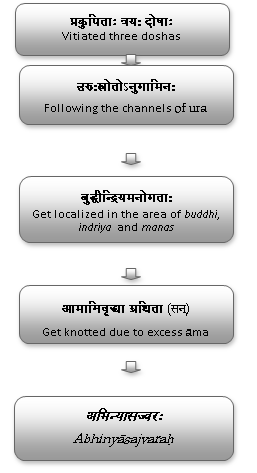
8. अभ्यन्तरायामः ( abhyantarāyāmaḥ)
The text
अङ्गुली-गुल्फ-जठर-हृद्वक्षो-गलसंश्रितः। स्नायुप्रतानमनिलो यदाऽऽक्षिपति वेगवान्॥
विष्टब्धाक्षः स्तब्धहनु-र्भग्नपार्श्वः कफं वमन्। अभ्यन्तरं धनुरिव यदा नमति मानवम् ॥
तदाऽस्याभ्यन्तरायामं कुरुते मारुतो बली। (वातव्याधिनिदानम् ३४-३५)
Easy Sanskrit meaning (anvaya)-
(कुपित:) वेगवान् अनिल: यदा अङ्गुलीगुल्फजठरहृद्वक्षोगलसंश्रितः स्नायुप्रतानम् आक्षिपति, विष्टब्धाक्षः, स्तब्धहनु: भग्नपार्श्वः कफं वमन् ; यदा बली मारुत: धनु: इव मानवम् अभ्यन्तरं नमति तदा अस्य अभ्यन्तरायामं कुरुते।
(कुपित:) वेगवान् अनिल: vitiated and vibrant vāyu |
English meaning : When vitiated and vibrant vāyu inlodges in the fingers, ankles, the trunk, precordial part, the chest and the neck, it causes indrawing of the snāyu and convulsions. Staring look, lock jaw, cracking pain in the sides of the chest and mucinous vomiting (are manifested along with). When the virulent māruta bends (the body) ventrally like a bow then it produces abhyantarāyāma of human.
Flow chart-

9. अम्लपित्तम् (Amlapittam)
The text विरुद्ध-दुष्टाम्ल-विदाहि-पित्तप्रकोपिपानान्नभुजो विदग्धम्।
पित्तं स्वहेतूपचितं पुरा यत्तदम्लपित्तं प्रवदन्ति सन्तः॥ (अम्लपित्त-निदानम् १-२)
Easy Sanskrit meaning (anvaya)-
पुरा स्वहेतु -उपचितं यत् पित्तं विरुद्धदुष्टाम्लविदाहिपित्तप्रकोपिपानान्नभुज: (मानवस्य) विदग्धं (जायते),तत् सन्त: अम्लपित्तम् प्रवदन्ति।
English meaning :
Pitta accumulated by its own factors when becomes vidagdha(turned into sour) due to intake of viruddha (incompatible), duṣṭa (unhygienic), (excessively) sour, vidāhi and pitta-vitiating food and drinks,thenthe condition is called amlapitta by the scholars.,
Flow chart-
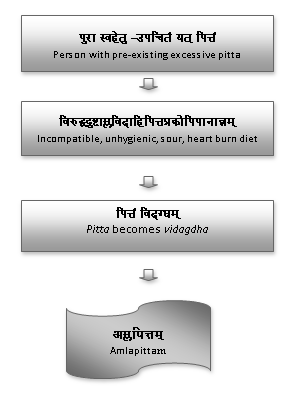
10. अर्दितः (Arditaḥ)
The text
उच्चैर्व्याहरतोऽत्यर्थं खादतः कठिनानि वा। हसतो जृम्भतो वाऽपि भाराद्विषमशायिनः॥
शिरो-नासौष्ठ-चिबुक-ललाटेक्षणसन्धिगः। अर्दयत्यनिलो वक्त्रमर्दितं जनयत्यतः।
(वातव्याधि-निदानम्/४४-४५)
Easy Sanskrit meaning (anvaya)- उच्चै: व्याहरत: अत्यर्थं कठिनानि खादतः वा, हसत: जृम्भत: वा, भारात् अपि, विषमशायिनः॥ शिरोनासौष्ठचिबुकललाटेक्षणसन्धिगः अनिल: वक्त्रम् अर्दयति,अत: (च) अर्दितं जनयति ।
English meaning :
Talking persistently at high voice, eating hard substance, laughing or yawning or lying on an uneven ground while carrying heavy load, vāyu located in head, nose, lips, chin, forehead and the eyes (gets vitiated) and afflicts the face and produces ardita (bending of face /angle of mouth).
Flow chart-
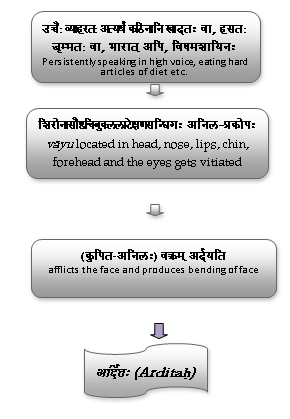
11. अर्बुदः (Arbudaḥ)
The text
गात्रप्रदेशे क्वचिदेव दोषाः सम्मूर्च्छिता मांसमसृक् प्रदूष्य।
वृत्तं स्थिरं मन्दरुजं महान्तमनल्पमूलं चिरवृद्ध्यपाकम्॥
कुर्वन्ति मांसोच्छ्रयमत्यगाधं तदर्बुदं शास्त्रविदो वदन्ति।
(गलगण्डगण्डमालऽपचीग्रन्थ्यर्बुदानिदानम् १८-१९)
Easy Sanskrit meaning (anvaya)-
गात्रप्रदेशे क्वचित् एव संमुर्च्छिता: दोषा: मांसम् असृक् (च) प्रदूष्य वृत्तं, स्थिरं, मन्दरुजं, महान्तम्, अनल्पमूलं, चिरवृद्ध्यपाकं, मांसोच्छ्रयम् अत्यगाधं च कुर्वन्ति, शास्त्रविद: तत् अर्बुदं वदन्ति।
English meaning :
aggravated doṣāḥ in any part of the body afflicting the māṁsa and rakta, produce a circular, fixed, mild painful, large, deep routed, slowly growing, non-suppurating and dense elevation.( swelling) of māṁsa (fleshy tissue); this is 'considered as arbudaḥ by the scholar .
Flow chart-
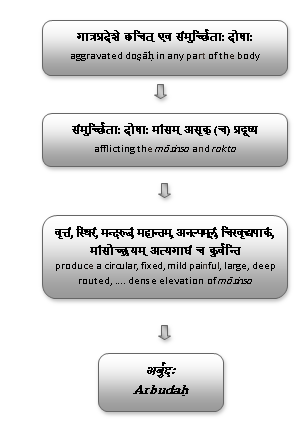
12. अर्शः (Arśaḥ)
The text
दोषास्त्वङ्मांसमेदांसि संदूष्य विविधाकृतीन्।
मांसाङ्कारानपानादौ कुर्वन्त्यर्शांसि ताञ्जगुः॥(अर्शोनिदानम् २)
Easy Sanskrit meaning (anvaya)-
दोषा: त्वक्-मांस-मेदांसि संदूष्य अपानादौ विविधाकृतीन् मांसाङ्कुरान् कुर्वन्ति٫ तान् अर्शांसि जगुः।
English meaning : The vitiated doṣāḥ afflictingthe tvak (the skin and mucosa), māṁsa (muscles) and meda (fatty tissue) produce fleshy sprouts of different forms in the apānadeśa (ano-rectal region etc.), these are known as arśāṁsi.
Flow chart-
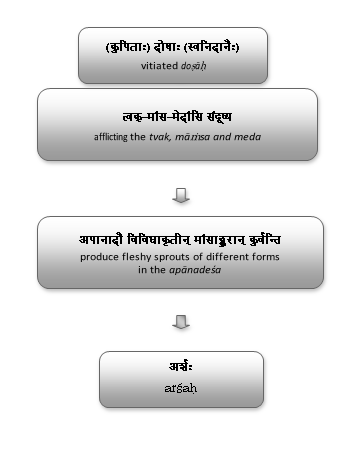
13.अवबाहुकः (Avabāhukaḥ)
The text
अंसदेशस्थितो वायुः शोषयेदंसबन्धनम् ॥
सिराश्चाकुञ्च्य तत्रस्थो जनयेदवबाहुकम्। (वातव्याधिनिदानम् ६५)
Easy Sanskrit meaning (anvaya)-
अंसदेशस्थित: वायुः अंसबन्धनं शोषयेत्। तत्रस्थ: च (वायु:) सिरा: आकुञ्च्य अवबाहुकं जनयेद।
English meaning : (vitiated) Vāyu, located in aṁsa-deśa (the shoulder region) causes wasting of the structures binding aṁśa. Inlodging there (the vitiated vāyu) contracturing the sirā (surrounding binding structures) produces avabāhuka.
Flow chart-
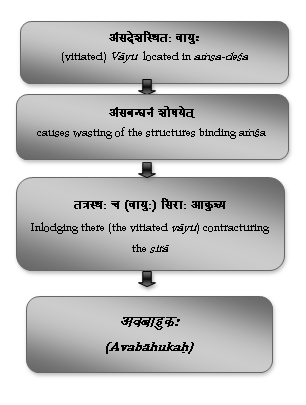
14. अश्मरी (Aśmarī)
The text
विशोषयेद्बस्तिगतं सशुक्रं मूत्रं सपित्तं पवनः कफं वा।
यदा तदाऽश्मर्युपजायते तु क्रमेण पित्तेष्विव रोचना गोः॥(अश्मरीनिदानम् २)
Easy Sanskrit meaning (anvaya) - यदा पवनः वस्तिगतं सशुक्रं मूत्रं सपित्तं कफं वा विशोषयेत्, तदा तु पित्तेषु रोचना इव क्रमेण अश्मरी उपजायते।
English meaning : When (vitiated)vāta parched up the urine in the bladder along with śukra, pitta or kapha, a calculus is gradually formed just as gall stones are formed from the bile of a cow.
Flow chart-
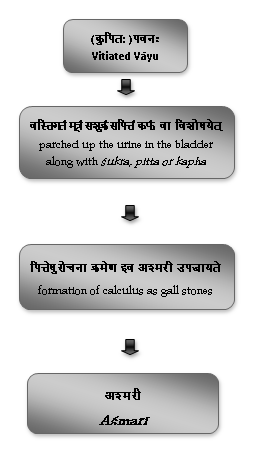
15. अष्ठीला (Aṣṭhīlā)
The text
आध्मापयन् बस्तिगुदं रुद्ध्वा वायुश्चलोन्नताम्।
कुर्यात्तीव्रार्तिमष्ठीलां मूत्र-विण्मार्गरोधिनीम्॥ (मूत्राघातनिदानम् ४)
Easy Sanskrit meaning (anvaya) –
वायु: बस्तिगुदम् आध्मापयन्, चलोन्नतां मूत्रविण्मार्गरोधिनीं तीव्रार्तिम् अष्ठीलां कुर्यात्।
English meaning : (Vitiated) vāyu obstructing the basti (urinary bladder) and the guda (the perennial) regions causes ādhmāna (distension over the bladder) and produces a movable, elevated and severely painful swelling i.e. aṣṭhīlā which obstructs the passages of urine and faeces.
Flow chart-
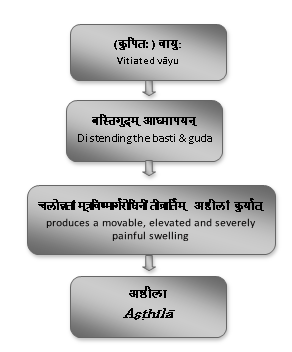
16. आक्षेपकः (Akṣepakaḥ )
The text
यदा तु धमनीः सर्वाः कुपितोऽभ्येति मारुतः। तदाऽऽक्षिपत्याशु मुहु-र्मुहुर्देहं मुहुश्चरः॥
मुहुर्मुहुश्चाक्षेपणादाक्षेपक इति स्मृतः। (वातव्याधिनिदानम २७)
Easy Sanskrit meaning (anvaya) –
यदातुकुपित: मारुतः सर्वाः धमनीः अभ्येति, तदा आशु देहं मुहु: मुहु:अक्षिपति मुहु: च चर: । मुहु: मुहु: चआक्षेपणात्,’आक्षेपक:’ इति (स:)स्मृतः।
English meaning : When vāyu gets vitiated and afflicts all the channels of the body then immediately it causes repeated convulsions in quick succession. On account of repeated appearance of convulsion this condition is known as ākṣepaka.
Flow chart-
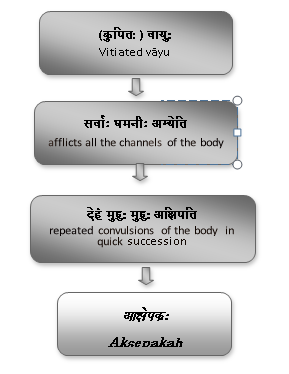
17. आनाहः (Ānāhaḥ)
The text
आमं शकृद्वा निचितं क्रमेण भूयो विबद्धं विगुणानिलेन।
प्रवर्तमानं न यथास्वमेनं विकारमानाहमुदाहरन्ति॥ (उदावर्तानाहनिदानम् १७)
Easy Sanskrit meaning (anvaya)-
आमं शकृत् वा क्रमेण, निचितं (भवेत्), भूय: विगुणानिलेन विबद्धं (भवेत्), यथास्वं प्रवर्तमानं न (भवेत्), एनं विकारम् आनाहम् उदाहरन्ति।
English meaning :
(When) the undigested food material or śakṛt (formed faeces) increasingly accumulate and then get blocked due to the vitiated vāta resulting in obstruction in natural onward movement is known as ānāhaḥ.
Flow chart-
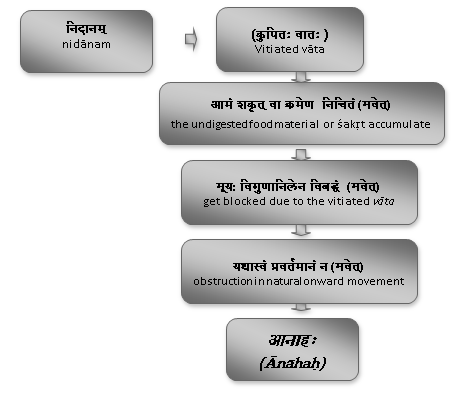
18. आमवातः (Āmavātaḥ)
The text
विरुद्धाहारचेष्टस्य मन्दाग्नेर्निश्चलस्य च।स्निग्धं भुक्तवतो ह्यन्नं व्यायामं कुर्वतस्तथा॥
वायुना प्रेरितो ह्यामः श्लेष्मस्थानं प्रधावति।तेनात्यर्थं विदग्धोऽसौ धमनीः प्रतिपद्यते॥
वात-पित्त-कफैर्भूयो दूषितः सोऽन्नजो रसः।स्रोतांस्यभिष्यन्दयति नानावर्णोऽतिपिच्छिलः॥
जनयत्याशु दौर्बल्यं गौरवं हृदयस्य च।व्याधीनामाश्रयो ह्येष आमसंज्ञोऽतिदारुणः॥
युगपत्कुपितावन्त-त्रिकसन्धिप्रवेशकौ।स्तब्धं च कुरुतो गात्रमामवातः स उच्यते॥
(आमवात-निदानम् १-५)
Easy Sanskrit meaning (anvaya)-
विरुद्धाहारचेष्टस्य, मन्दाग्ने: निश्चलस्य, स्निग्धम् अन्न भुक्तवत: तथा च व्यायामं कुर्वत: (मानवस्य) आम: हि वायुना प्रेरित: श्लेष्मस्थानं प्रधावति, तेन अत्यर्थं विदग्ध: असौ वातपित्तकफै: भूय: दूषितः धमनीः प्रतिपद्यते, अन्नज: रस: नानावर्ण: अतिपिच्छिलः च स स्रोतांसि अभिष्यन्दयति, दौर्बल्यं हृदयस्य गौरवं च आशु जनयति । एष: हि आमसंज्ञ: व्याधीनाम् आश्रय: अतिदारुणः (च)। युगपत् कुपितौ अन्त:-त्रिकसन्धिप्रवेशकौ। स्तब्धं च कुरुत: स: आमवातः उच्यते।
English meaning :
When person having sedentary habits and hypo functioning of digestive fire intakes incompatible diet and regimen, or does physical exercise after taking unctuous food the āma is produced and propelled out by vāyu and reaches the site of śleṣmā. That (āma), being improperly digested and severely vitiated by vāta, pitta and kapha is transported (all over the body) through the dhamanī. In due course it takes on multiple colours, becomes excessively lubricous and accumulates in the channels. It produces weakness, heaviness in the precordial region immediately. This substance named āma is the invariable route cause of various distressing diseases. When this vitiated āma simultaneously afflicts the trika and other joints causing the body stiff, the state is called as āmavāta.
Flow chart-
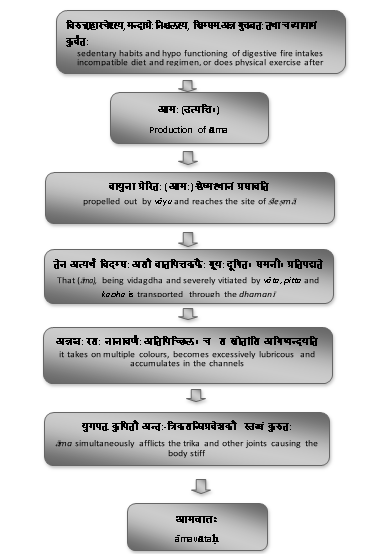
19.आमातिसारः (Āmātisāraḥ)
The text
अन्नाजीर्णात् प्रद्रुताः क्षोभयन्तः कोष्ठं दोषा धातुसड्घान्मलांश्च ।
नानावर्णं नैकशः सारयन्ति शूलोपेतं षष्ठमेनं वदन्ति॥ (अतिसारनिदानम् ११)
Easy Sanskrit meaning (anvaya)-
अन्नाजीर्णात् प्रद्रुताः दोषा: कोष्ठं धातुसड्घान् मलान् च क्षोभयन्तः, नानावर्णं नैकशः शूलोपेतं सारयन्ति, एनं षष्ठं वदन्ति।
English meaning :
Vitiated doṣāḥ, on account of improper digestion of food, agitate the koṣṭha (alimentary canal), the dhātu and the mala ; and subsequently, they push out the faeces of various colours repeatedly with pain.
Flow chart-
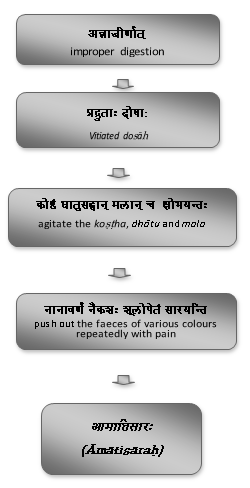
20. इन्द्रलुप्तः (Indraluptaḥ)
The text
रोमकूपानुगं पित्तं वातेन सह मूर्च्छितम्।प्रच्यावयति रोमाणि ततः श्लेष्मा सशोणितः॥
रुणद्धि रोमकूपांस्तु ततोऽन्येषामसम्भवः।तदिन्द्रलुप्तं खालित्यं रूह्येति च विभाव्यते॥
(क्षुद्ररोगनिदानम् २८-२९)
Easy Sanskrit meaning (anvaya)-
रोमकूपानुगं पित्तं वातेन सह मूर्च्छितं रोमाणि प्रच्यावयति। ततः सशोणितः श्लेष्मा रोमकूपान् रुणद्धि तत: तु अन्येषां (रोमकूपान्) असम्भवः। तत् इन्द्रलुप्तम् (इति कथ्यते)। (तत्) खालित्यं रूह्य इति च विभाव्यते।
English meaning : (Vitiated)Pitta inlodging in the hair-pits and getting associated with vāta causes fall of the hairs; subsequently kapha, along with rakta, blocking the hair-pits makes it impossible to grow new hairs. This condition is considered as indralupta, khālitya or rūhya.
Flow chart-
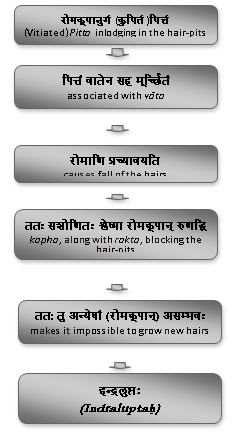
21. उदरम् (Udaram)
The text
रुद्ध्वा स्वेदाम्बुवाहीनि दोषाः स्रोतांसि सञ्चिताः।
प्राणाग्न्यपानान् संदूष्य जनयन्त्युदरं नृणाम् ॥ (उदररोगनिदानम् १-२)
Easy Sanskrit meaning (anvaya)-
संचिताः दोषाः स्वेदाम्बुवाहीनि स्रोतांसि रुद्ध्वा प्राणाग्न्यपानान् संदूष्य नृणाम् उदरं जनयन्ति।
English meaning :
The accumulated doṣāḥ obstructing the sweat and water-carrying channels and afflicting the prānavāyu, apāna-vāyu and pācakāgni (the digestive fire) and produce udara in human.
Flow chart-
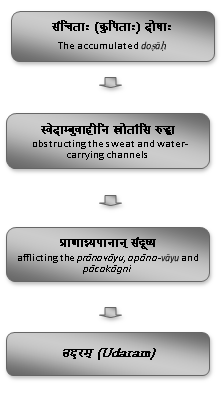
22. उन्मादः (Unmādaḥ)
The text
तैरल्पसत्त्वस्य मलाः प्रदुष्टा बुद्धेर्निवासं हृदयं प्रदूष्य।
स्रोतांस्यधिष्ठाय मनोवहानि प्रमोहयन्त्याशु नरस्य चेतः॥ (उन्मादनिदानम् ४-६)
Easy Sanskrit meaning (anvaya)-
तै: प्रदुष्टा: मला: अल्पसत्त्वस्य बुद्धे: निवासं हृदयं प्रदूष्य, मनोवहानि स्रोतांसि अधिष्ठाय (च) नरस्य चेतः आशु प्रमोहयन्ति।
English meaning :
On account of the aetiological factors the vitiated malāḥ (doṣāḥ), in human with a deficit of sattva, afflicting the hṛdaya, the seat of intellect and inlodging in channel of manavaha quickly derange the mental functions of the human.
Flow chart-
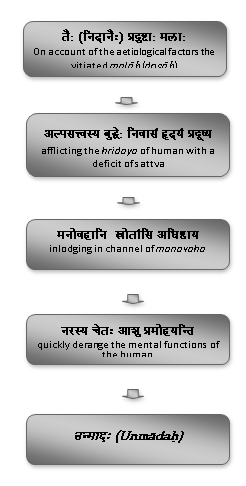
23.उष्णवातः (Uṣṇavātaḥ)
The text
व्यायामाध्वातपैः पित्तं बस्तिं प्राप्यानिलान्वितम्॥ बस्तिं मेढ्रं गुदं चैव प्रदहेत् स्रावयेदधः।
मूत्रं हारिद्रमथवा सरक्तं रक्तमेव वा॥ कृच्छ्रात् पुनः पुनर्जन्तोरुष्णवातं ब्रुवन्ति तम्।
(मूत्राघातनिदानम् १५-१७)
Easy Sanskrit meaning (anvaya)-
व्यायामाध्वातपैः अनिलान्वितं पित्तं बस्तिं प्राप्य बस्तिं मेढ्रं गुदं च प्रदहेत्, अध: च हारिद्रं सरक्तं वा मूत्रम् अथवा रक्तम् एव वा स्रावयेत्। पुनः पुन: जन्त: कृच्छ्रात् (स्रावयेत् )। तम् उष्णवातं ब्रुवन्ति।
English translation :
Pitta, vitiated on account of excessive physical exercise, long journey and exposure to the sun, along with (vitiated) vāyu afflicting basti (the urinary bladder) produces burning sensation in the urinary bladder, penis and rectum; and he then passes urine either in turmeric coloured or mixed with blood or consists of fresh blood only along with difficulty again and again. This is known as uṣṇavāta.
Flow chart-
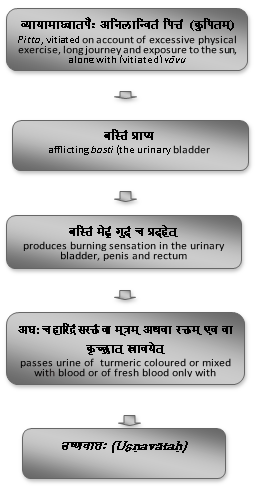
24. ऊरुस्तम्भः (ūrustambhaḥ)
The text
शीतोष्ण-द्रव-संशुष्क-गुरु-स्निग्धैर्निषेवितैः। जीर्णाजीर्णे तथाऽऽयास-संक्षोभ-स्वप्न-जागरैः॥
सश्लेष्म-मेदः पवनः साममत्यर्थसञ्चितम्। अभिभूयेतरं दोषमुरु चेत् प्रतिपद्यते॥
सक्थ्यस्थिनी प्रपूर्यान्तः श्लेष्मणा स्तिमितेन च। तदा स्तभ्नाति ... (ऊरुस्तम्भनिदानम् १-५)
Easy Sanskrit meaning (anvaya)-
शीतोष्णद्रवसंशुष्कगुरुस्निग्धै: निषेवितैः जीर्णाजीर्णे, तथा च आयाससंक्षोभस्वप्नजागरैः अत्यर्थसंचितं सामं सश्लेष्ममेदः पवनः इतरं दोषम् अभिभूयः ऊरु प्रतिपद्यते चेत्, (यदा) सक्थ्यस्थिनी स्तिमितेन अन्तःश्लेष्मणा प्रपूर्य च तदा स्तभ्नाति।
English meaning :
Vitiated vāyu, on account of (excessive) consumption of cold, hot, liquid, very dry, heavy and fatty food, without considering the digestion status of the previous meal and also (tiredness) due to excessive physical work, undue strain, (day) sleep, or wakefulness, in association with too much of accumulated āma, kapha and meda subdues the other doṣa (pitta), drifts to the thighs and pluging up the musculo-skeletal system of the thigh with the moist kapha causes stiffness (of both thighs).
Flow chart-
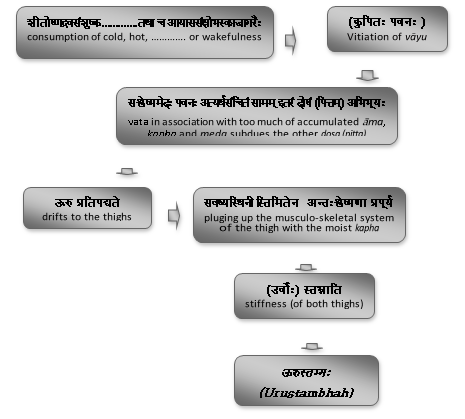
25. कर्णशूलः (Karṇaśūlaḥ)
The text
समीरणः श्रोत्रगतोऽन्यथाचरन् समन्ततः शूलमतीव कर्णयोः।
करोति दोषैश्च यथास्वमावृतः स कर्णशूलः कथितो दुराचरः॥(कर्णरोगनिदानम् १)
Easy Sanskrit meaning (anvaya)-
यथास्वं दोषै: आवृतः अन्यथाचरन् च समीरणः श्रोत्रगत: समन्ततः कर्णयोः अतीव शूलं करोति, स: दुराचरः (व्याधि:) कर्णशूलः कथित:।
English meaning : Vāyu, enveloped by the other doṣāḥ (vitiated) on account of their own vitiating factors,navigating abnormally through the ear passages and produces severe pain in the ears. This severe condition iscalled karṇaśūla.
Flow chart-
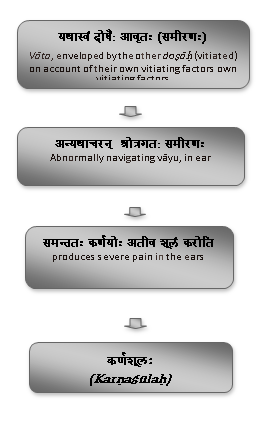
26. कामला (Kāmalā)
The text
पाण्डुरोगी तु योऽत्यर्थं पित्तलानि निषेवते। तस्य पित्तमसृङ्मांसं दग्ध्वा रोगाय कल्पते॥
हारिद्रनेत्रः स भृशं हारिद्रत्वङ्नखाननः।( पाण्डुरोगकामलाकुम्भकामलादिनिदानम् १६-१८)
Easy Sanskrit meaning (anvaya)-
य: पाण्डुरोगी अत्यर्थं पित्तलानि निषेवते तस्य पित्तम् असृङ्मांसं दग्ध्वा रोगाय कल्पते।
English meaning :
When Pāṇḍu patientcontinues to take pitta-vitiating foodsubstances, the pitta further vitiating rakta and māṁsa produces the disease (jaundice, kāmalā). The patient develops yellow discolouration of the eyes, the skin, the nails and the face.
Flow chart-
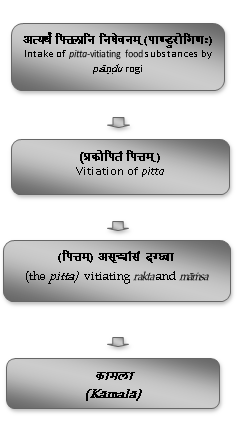
27. कासः (Kāsaḥ)
The text
धूमोपघाताद्रसतस्तथैव व्यायाम-रूक्षान्ननिषेवणाच्च।विमार्गगत्वाच्च हि भोजनस्य वेगावरोधात् क्षवथोस्तथैव॥
प्राणो ह्युदानानुगतः प्रदुष्टः स भिन्नकांस्यस्वनतुल्यघोषः।निरेति वक्त्रात् सहसा सदोषो मनीषिभिः कास इति प्रदिष्टः ॥ (कास-निदानम्/१-२ )
Easy Sanskrit meaning (anvaya)-
धूमोपघातात्, रसत: तथैव च व्यायामरूक्षान्ननिषेवणत् , भोजनस्य विमार्गगत्वात्, वेगावरोधात् तथैव क्षवथो: च (कासोत्पत्तिः जायते)। प्रदुष्टः प्राण: हि उदानानुगतः भिन्नकांस्यस्वनतुल्यघोषः सदोष: वक्त्रात् सहसा निरेति, स: मनीषिभिः कास: इति प्रदिष्टः।
English meaning :
Vitiated prāṇa-vāyu due to exposure to smoke and dust particles, (excessive) exercise, consumption of dry (non-unctous) food, entry of food into the wrong way and the suppression of sneezing urge, etc. associated with the udāna vāyu produces a loud noise like that of cracked bell-metal (vessel) and abruptly expells out of the mouth with or without expectoration. This is called kāsa by the scholar.
Flow chart-
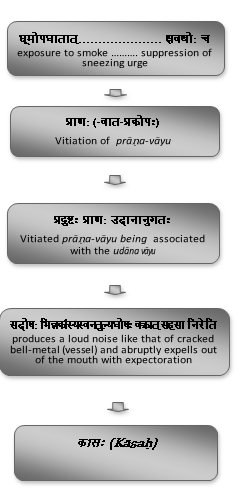
The text
विरोधीन्यन्नपानानि द्रव-स्निग्ध-गुरुणि च।…वातादयस्त्रयो दुष्टा-स्त्वग्रक्तं मांसमम्बु च॥
दूषयन्ति स कुष्ठानां सप्तको द्रव्यसंग्रहः। (कुष्ठनिदानम् ५-६)
Easy Sanskrit meaning (anvaya)-
विरोधीनि अन्नपानानि द्रवस्निग्धगुरुणि च (निषेविणाम्)… वातादय: त्रय: (दोषा:) दुष्टा: (सन्त:) त्वग्रक्तं मांसम् अम्बु च दूषयन्ति। स: एव सप्तक: कुष्ठानां द्रव्यसंग्रहः।
English meaning : Doṣāḥ (all three doṣāḥ) geting vitiated by indulgence in incompatible food and drinks, (excess) intake of liquid, unctous and heavy diet afflict the tvak,rakta, māṁsa and ambu (the skin, blood, muscles and body fluids). this is the group of seven bio-elements responsible for kuṣṭha.
Flow chart-
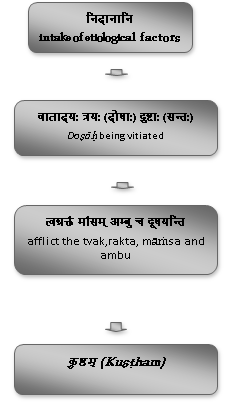
The text
विषमासात्म्यभोज्याति-व्यवायाद्वेगनिग्रहात्। घृणिनां शोचतां नॄणां व्यापन्नेऽग्नौ त्रयो मलाः।
कुपिताः क्षयजं कासं कुर्युर्देहक्षयप्रदम्॥ (कासनिदानम् १२-१३)
Easy Sanskrit meaning –
विषमासात्म्यभोज्यातिव्यवायात्, वेगनिग्रहात्, घृणिनां शोचतां (च) नॄणाम् अग्नौ व्यापन्ने (च) कुपिताः त्रय: मला: देहक्षयप्रदं क्षयजं कासं कुर्यु:।
English meaning : Vitiated three doṣāḥ on account of irregular dietary habits, unsalutary food, excessive coitus and suppression of the natural urges and malicious nature as well as those in grief, in a person having impaired digestive power (due to same causes), produce the kṣayaja variety of kāsa (cough) which causes emaciation of the body.
Flow chart-
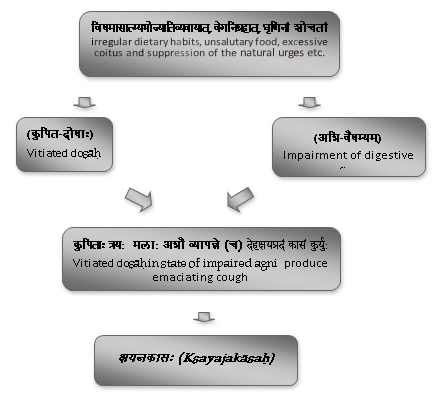
30.खञ्जः (Khanjaḥ)
The text
वायुः कट्याश्रितः सक्थ्नः कण्डरामाक्षिपेद्यदा॥
खञ्जस्तदा भवेज्जन्तुः पङ्गुः सक्थ्नोर्द्वयोर्वधात्। (वातव्याधिनिदानम् ५९)
Easy Sanskrit meaning (anvaya)-
यदा वायुः कट्याश्रितः सक्थ्नः कण्डराम् आक्षिपेत्, तदा जन्तुः खञ्ज: भवेत्। द्वयो: सक्थ्नो: वधात् पङ्गुः (भवेत्)।
English meaning :
When the aggravated vayu inlodged in the kaṭi ( lumbar region) afflicts kaṇḍarā of sakthi (the big nerves of one lower extremity), then human becomes kha²ja; whereas when both the sakthi are afflicted it is called paṅgu.
Flow chart-
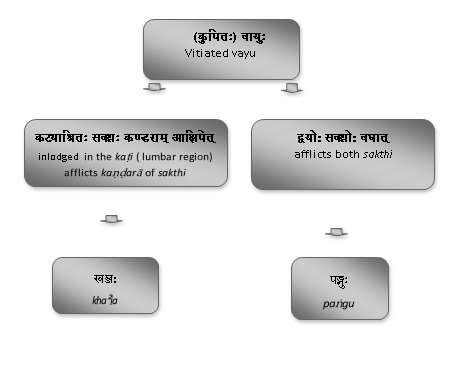
31.गलगण्डः (Galagaṇḍaḥ)
The text
वातः कफश्चापि गले प्रदुष्टो मन्ये च संश्रित्य तथैव मेदः।
कुर्वन्ति गण्डं क्रमशः स्वलिङ्गैः समन्वितं तं गलगण्डमाहुः॥
(गलगण्डगण्डमालाऽपचीग्रन्थ्यर्बुदादि-निदानम् २)
Easy Sanskrit meaning (anvaya)-
वातः कफ: तथैव च मेदः अपि प्रदुष्ट: गले मन्ये च संश्रित्य क्रमशः स्वलिङ्गैः समन्वितं गण्डं कुर्वन्ति। तं गलगण्डम् आहुः।
English meaning :
Vitiated vāta and kapha along with meda getting inlodged in the neck.and in the manyā regions, gradually produce a localised swelling presenting with the clinical features of own types ; it is- called galagaṇḍa.
Flow chart-
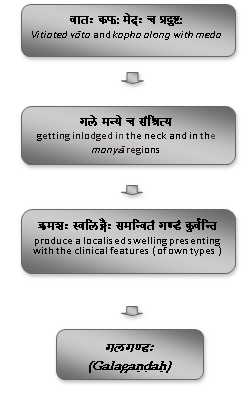
32.ग्रन्थिः (Granthiḥ)
The text
वातादयो मांसमसृक् प्रदुष्टाः संदूष्य मेदश्च तथा सिराश्च।
वृत्तोन्नतं विग्रथितं च शोथं कुर्वन्त्यतो ग्रन्थिरिति प्रदिष्टः॥
(गलगण्डगण्डमालाऽपचीग्रन्थ्यर्बुदादिनिदानम् ११)
Easy Sanskrit meaning (anvaya)-
वातादय: प्रदुष्टाः मांसम्, असृक् मेद: तथा च सिरा: च संदूष्य वृत्तोन्नतं विग्रथितं च शोथं कुर्वन्ति, अत: ग्रन्थि: इति प्रदिष्टः।
English meaning : Vitiated vāta and other doṣāḥ afflicting māṁsa, rakta, meda and sirā produce a circular, elevated and knotted swelling which is known as granthi.
Flow chart-
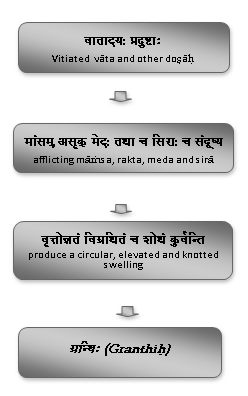
33. ग्रहणी (Grahaṇī)
The text
अतिसारे निवृत्तेऽपि मन्दाग्नेरहिताशिनः।भूयः संदूषितो वह्निर्ग्रहणीमभिदूषयेत्॥
एकैकशः सर्वशश्च दोषैरत्यर्थमूर्च्छितैः। सा दुष्टा बहुशो भुक्तमाममेव विमुञ्चति॥
पक्वं वा सरुजं पूति- मुहुर्बद्धं मुहुर्द्रवम्। ग्रहणीरोगमाहुस्तमायुर्वेदविदो जनाः॥
(ग्रहणीनिदानम्/१-३ )
Easy Sanskrit meaning (anvaya)-
अतिसारे निवृत्ते अपि अहिताशिन: मन्दाग्ने: (पुरुषस्य) वह्नि: भूयः संदूषित:(सन्) ग्रहणीम् अभिदूषयेत् ।एकैकशः सर्वश: च अत्यर्थमूर्च्छितैः दोषै: दुष्टा सा बहुश: भुक्तम् आमम् एव विमुञ्चति। पक्वं सरुजं वा पूति मुहु: बद्धं मुहु: द्रवं , तम् आयुर्वेदविद: जना: ग्रहणीरोगम् आहु:।
English meaning: When a person of weak digestive power, even after remission of atisāra, takes unfavorable food his digestive power getting worsed further afflicts the grahaṇī. The grahaṇī, severely afflicted by the vitiated doṣāḥ either separately or in combination, evacuates the food in the undigested form, or digested form with pain and foul smell and sometimes in loose state sometimes in the well-formed state. This condition is termed as the grahaṇī disease by the āyurveda stalwarts.
Flow chart-
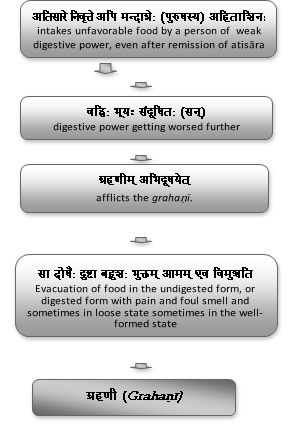
34.चतुर्विध-स्रावः (Caturvidhasrāvaḥ)
The text
गत्वा सन्धीनश्रुमार्गेण दोषाः कुर्युः स्रावान् लक्षणैः स्वैरुपेतान्।
तं हि स्रावं नेत्रनालीति चैके तस्या लिङ्गं कीर्तयिष्ये चतुर्धा॥ (नेत्ररोगनिदानम् १२)
Easy English meaning (anvaya)-
अश्रुमार्गेण दोषाः सन्धीन् गत्वा स्वै: लक्षणैः उपेतान् स्रावान् कुर्युः। तं स्रावं हि एके नेत्रनाडी इति (वदन्ति),
English meaning :
(Vitiated) doṣāḥ arriving at sandhi (the junctional areas) through the tear channels produce discharges of own kind (doṣa). These discharges are considered as netranāḍī by some scholars.
Flow chart-
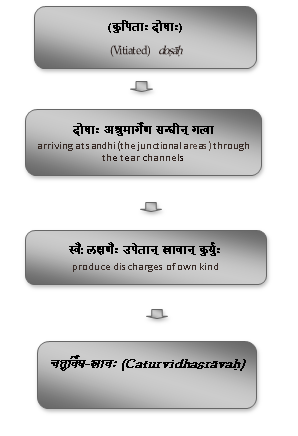
35.चर्मकीलः (Carmakīlaḥ)
The text
व्यानो गृहीत्वा श्लेष्माणं करोत्यर्शस्त्वचो बहिः।
कीलोपमं स्थिरखरं चर्मकीलं तु तद्विदुः॥ (अर्शनिदानम्/४३ )
Easy Sanskrit meaning (anvaya)-
व्यान: श्लेष्माणं गृहीत्वा, त्वच: बहि: अर्श: करोति। तत् तु (अर्शः) कीलोपमं٫ स्थिर-खरं, चर्मकीलं विदुः|
English meaning :
(Vitiated) Vyāna-vāyu afflicting the śleṣmā produces arśa (pile like lesions) in the skin externally; these are fixed and form like bolt and are called Carmakīla.
Flow chart-
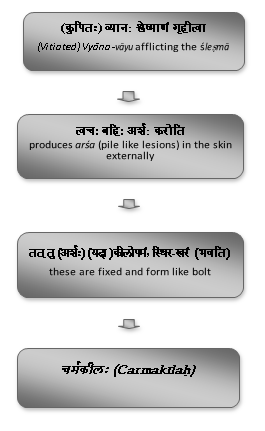
36.छर्दिः (Chardiḥ)
The text
अतिद्रवैरतिस्निग्धैरहृद्यैर्लवणैरति। अकाले चातिमात्रैश्च तथाऽसात्म्यैश्च भोजनैः॥
श्रमाद्भयात्तथोद्वेगा-दजीर्णात् क्रिमिदोषतः। नार्याश्चापन्नसत्त्वाया-स्तथाऽतिद्रुतमश्नतः॥
बीभत्सैर्हेतुभिश्चान्यै-र्द्रुतमुत्क्लेशितो बलात्। छादयन्नाननं वेगै-रर्दयन्नङ्गभञ्जनैः।
निरुच्यते छर्दिरिति दोषो वक्त्रं प्रधावितः ॥ (छर्दि-निदानम्/२-४ )
Easy Sanskrit meaning (anvaya)-
अतिद्रवै: अतिस्निग्धै:,अहृद्यै: अतिलवणै: अकाले च अतिमात्रै: च, असात्म्यै: च भोजनैः श्रमात् भयात् उद्वेगात्, अजीर्णात् क्रिमिदोषतः, आपन्नसत्त्वाया: नार्या: तथा च अतिद्रुतम् अश्नतः अन्यै: बीभत्सै: हेतुभि: बलात् द्रुतम् उत्क्लेशित: (दोष:) आननं छादयन् अङ्गभञ्जनैःवेगै: वक्त्रम् अर्दयन् प्रधावितः दोष: ’छर्दि’ इति, निरुच्यते।
English meaning :
Vitiated doṣāḥ due to excess intake of liquids, unctous substances, intake of disagreeable articles, too much of salts, taking meals at improper times or overeating, consumption of unsuitable diet, fatigue, fear, stress, indigestion, worm infestations, pregnancy in women and rapid intake of meals and due to other cause forcibly propelled fast and welling up in the oral cavity expel through the mouth distressing the body along with a sensation as if the body parts are being smashed; this is thus called chardi (etymologically).
Flow chart-
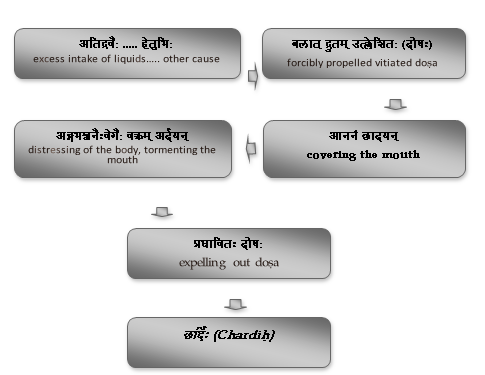
37.जिह्वास्तम्भः (Jihvāstambhaḥ)
The text
वाग्वाहिनीसिरासंस्थो जिह्वां स्तम्भयतेऽनिलः।
जिह्वास्तम्भः स तेनान्न-पानवाक्येष्वनीशता॥ (वातव्याधिनिदानम् ५२)
Easy Sanskrit meaning (anvaya)-
वाग्वाहिनीसिरासंस्थ:, अनिल: जिह्वां स्तम्भयते स: जिह्वास्तम्भः (कथ्यते)। तेन अन्नपानवाक्येषु अनीशता (स्यात्)।
English meaning : (Vitiated) vāyu inlodging in the speech-carrying channel produces immobility of the tongue. This is called jihvāstambhaḥ. There is difficulty in the swallowing of food and drinks and in speaking.
Flow chart-
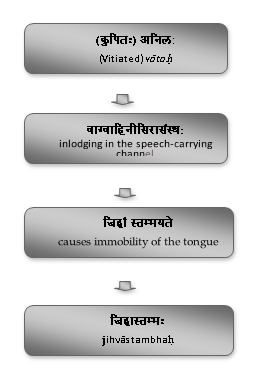
38.ज्वरः (Jvaraḥ)
The text
मिथ्याहारविहाराभ्यां दोषा ह्यामाशयाश्रयाः।
बहिर्निरस्य कोष्ठाग्निं ज्वरदाः स्यू रसानुगाः॥ (ज्वरनिदानम्/२)
Easy Sanskrit meaning (anvaya)-
मिथ्याहारविहाराभ्यां (प्रकुपिताः) दोषा:(वात-पित-कफा:)आमाशयाश्रयाः हि रसानुगा: स्यु:। (ते) कोष्ठाग्निं बहि: निरस्य ज्वरदाः(स्यु:)।
English meaning: On account of improperdietary and behavioural regimen, the (vitiated) doṣāḥ inlodge in āmāśaya. They drive outthe koṣṭhāgni and following the route of rasa produces jvara.
Flow chart-
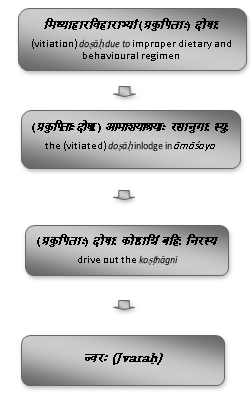
39. तमक-श्वासः (Tamaka-śvāsaḥ)
The text
प्रतिलोमं यदा वायुः स्रोतांसि प्रतिपद्यते।ग्रीवां शिरश्च संगृह्य श्लेष्माणं समुदीर्य च॥
करोति पीनसं तेन रुद्धो घुर्घुरकं तथा।अतीव तीव्रवेगं च श्वासं प्राणप्रपीडकम्॥
(हिक्काश्वासनिदानम् २७-३४)
Easy Sanskrit meaning (anvaya)-
यदा प्रतिलोमं वायुः स्रोतांसि प्रतिपद्यते, ग्रीवां शिर: च संगृह्य श्लेष्माणं च समुदीर्य पीनसं करोति, (तदा) तेन रुद्ध: (वायु:) घुर्घुरकं, प्राणप्रपीडकम् अतीवतीव्रवोगं च श्वासं (तमकश्वासं) (करोति)।
English meaning :
When the (vitiated) vāyu being in reversed course, reaches the respiratory tract and laying clutch of the neck and the head and provoking up the kapha, then it produces pīnasa. (There) being obstructed by this pīnasa (the vitiated vāyu) produces life threatening, severe śvāsa associated with wheezing sound.
Flow chart-
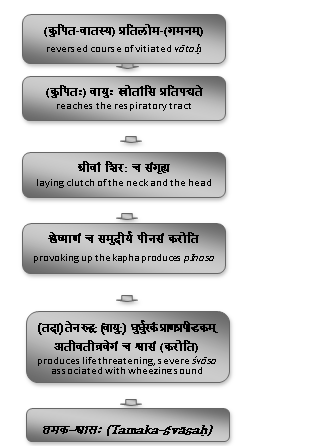
40. तृष्णा (Tṛṣṇā)
The text
भय-श्रमाभ्यां बलसंक्षयाद्वा ह्यूर्ध्वं चितं पित्तविवर्धनैश्च।
पित्तं सवातं कुपितं नराणां तालुप्रपन्नं जनयेत् पिपासाम्।
स्रोतस्स्वपांवाहिषु दूषितेषु दोषैश्च तृट् सम्भवतीह जन्तोः॥ (तृष्णा-निदानम्/१-२ )
Easy Sanskrit meaning (anvaya)-
भयश्रमाभ्यां बलसंक्षयाद वा हि पित्तविवर्धनै: च चितं सवातं कुपितं पित्तं नराणां तालुप्रपन्नं पिपासां जनयेत्। इह दोषै: अपां वाहिषुस्रोत:सु दूषितेषु (सत्सु) जन्तोः तृट् सम्भवती।
English meaning :
Vitiated and accumulated pitta on account of fright, physical exertion or loss of potential strength, or due to other pitta-aggravating causes in the human beings along with vāyu, approaches upwards and reaching the tālu (palatal region) causes pipāsā (thirst). Here the water-carrying channels consequently get vitiated by the doṣa and thirst (undue) is felt by human.
Flow chart-
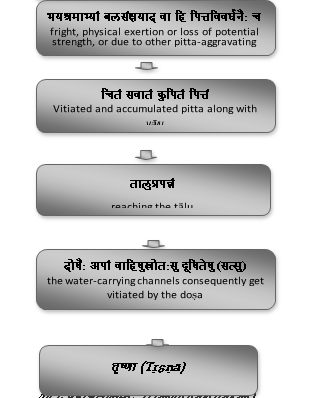
41. दण्डापतानकः (Daṇḍāpatānakaḥ)
The text
कफान्वितो भृशं वायुस्तास्वेव यदि तिष्ठति॥
दण्डवत् स्तम्भयेद्देहं स तु दण्डापतानकः। (वातव्याधि-निदानम्/३२ )
Easy Sanskrit meaning (anvaya)-
यदि कफान्वित: वायु: भृशं तासु एव तिष्ठति, (तर्हि) देहं दण्डवत् स्तम्भयेत्, स: तु दण्डापतानकः (कथ्यते)।
English meaning :
The severely vitiated vāyu associated with kapha wheninlodges the same (vātavaha srotas) and causes the whole body inflexible like a stick, (then) that is called daṇḍāpatānakaḥ.
Flow chart-
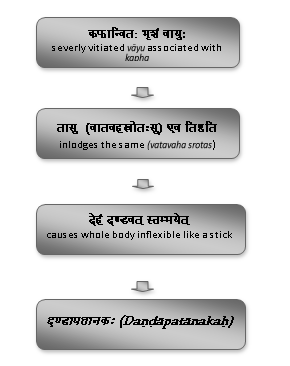
42. नाडीव्रणः (Nāḍīvraṇam)
The text
यः शोथमाममतिपक्वमुपेक्षतेऽज्ञो यो वा व्रणं प्रचुरपूयमसाधुवृत्तः।
अभ्यन्तरं प्रविशति प्रविदार्य तस्य स्थानानि पूर्वविहितानि ततः स पूयः॥
तस्यातिमात्रगमनाद्गतिरिष्यते तु नालीव यद्वहति तेन मता तु नाली। (नाडीव्रणनिदानम् १-२)
Easy Sanskrit meaning (anvaya)-
यः अज्ञ: अतिपक्वं शोथम् आमम् उपेक्षते वा यः असाधुवृत्तः प्रचुरपूयं व्रणं उपेक्षते, तत: स: पुय: तस्य पूर्वविहितानि स्थानानि प्रविदार्य अभ्यन्तरं प्रविशति ततः स पूयः।तस्य तु अतिमात्रगमनात् गति: इष्यते। या नाडी इव यद् वहति तेन तु नाडी मता।
English meaning :
When an ignorant person overlooks an excessively mature śotha as /immature one or ignores a vraṇa (ulcer) with profuse pus due to his depraved behaviour, then that pus afflicting the aforesaid sites (tissues) trails through them to the interior. That gets a momentum and flows like a tract and is thus called nāḍī.
Flow chart-
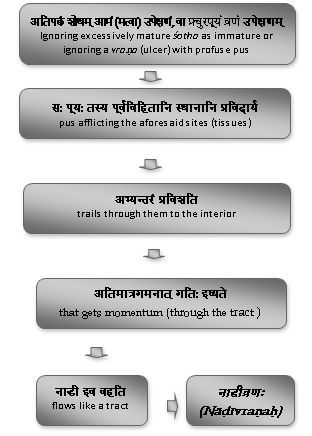
43.निमेषः (Nimēṣaḥ)
The text
निमेषिणीः सिरा वायुः प्रविष्टः सन्धिसंश्रयाः।
प्रचालयति वर्त्मानि निमेषं नाम तद्विदुः॥(नेत्ररोगनिदानम् ९२)
Easy Sanskrit meaning (anvaya)-
सन्धिसंश्रयाः निमेषिणीः सिरा: वायुः प्रविष्टः वर्त्मानि प्रचालयति तत् निमेषं नाम विदुः।
English meaning :
(Vitiated )vāyu, penetrating the sirā of the sandhi responsible for closure (and opening) of the lids, produces frequent blinking movements of eyelids. This is called nimeṣa.
Flow chart-
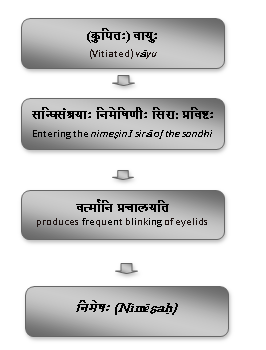
44. पक्षवधः (Pakṣavadhaḥ)
The text
गृहीत्वाऽर्धं तनोर्वायुः सिराः स्नायूर्विशोष्य च॥ पक्षमन्यतरं हन्ति सन्धिबन्धान् विमोक्षयन्।
कृत्स्नोऽर्धकायस्तस्य स्यादकर्मण्यो विचेतनः॥ एकाङ्गरोगं तं केचिदन्ये पक्षवधं विदुः।
(वातव्याधि-निदानम्/३९-४१ )
Easy Sanskrit meaning (anvaya)-
(स्वै: कोपनै: कुपित:) वायु: ततो: अर्धं गृहीत्वा सिराः स्नायू: च विशोष्य सन्धिबन्धान् विमोक्षयन् अन्यतरं पक्षं हन्ति, तस्य कृत्स्न: अर्धकाय: अकर्मण्य: विचेतनः (च) स्यात् तं केचित् एकाङ्गरोगम् अन्ये (च) पक्षवधं विदुः।
English meaning
(on account of its own categorical aetiological factors,Vitiated) vāyu, involving one-half of the body and afflicting the sirā and the snāyu and loosening the ligaments of the joints, damages the other half of the body. There appears loss of motor fuन्ction and sensory perception of the patient's whole body or of a half of it. It is known as ekāṅga-rogaḥ by the scholars while others name it as pakṣavadhaḥ.
Flow chart-
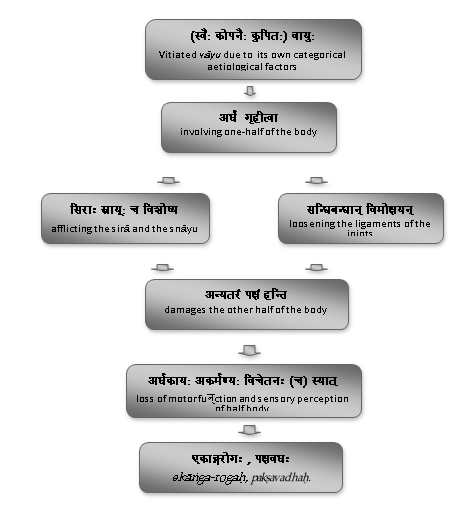
45. सर्वाङ्गरोग: (Sarvāṅgarogaḥ)
The text
सर्वाङ्गरोगं तद्वच्च सर्वकायाश्रितेऽनिले॥ (वातव्याधि-निदानम्/३९-४१ )
Easy Sanskrit meaning (anvaya)-
सर्वकायाश्रिते अनिले च तद्वत् सर्वाङ्गरोग: (जायते)।
English meaning
if the viatiated vāyu afflicts the whole body (like ekāṅgarogaḥ),it is known as sarvāṅgarogaḥ.
Flow chart-
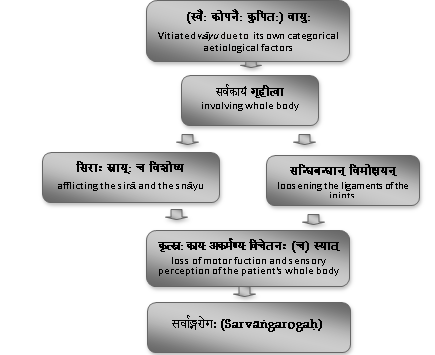
46. परिणामशूलः (Parinamaśūlaḥ)
The text
स्वैर्निदानैः प्रकुपितो वायुः सन्निहितस्तदा॥ कफ-पित्ते समावृत्य शूलकारी भवेद्बली।
भुक्ते जीर्यति यच्छूलं तदेव परिणामजम्॥ (शुलपरिणामशूलात्रद्रवशूल-निदानम् १५-२१)
Easy Sanskrit meaning (anvaya)-
स्वै: निदानैः प्रकुपित: तदा संनिहित: वायु: कफपित्ते समावृत्य शूलकारी बली भवेत् ।यत् शूलं भुक्ते जीर्यति तद् एव परिणामजम् (उच्यते)|
English translation -
Vitiated vāyu, on account of its own categorical aetiological factors, when gets confined and becomes more powerful with getting enveloped by kapha and pitta, produces colicky pain. When this pain appears during the period of digestion , it is known as parinamaja śūla .
Flow chart-
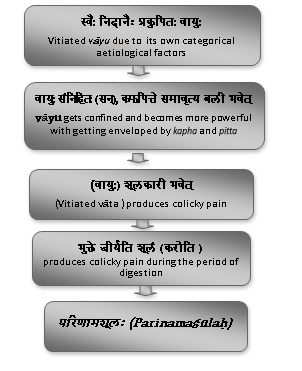
47. परिवर्तिका (Parivartikā)
The text
मर्दनात् पीडनाद्वाऽति तथैवाप्यभिघाततः। मेढ्रचर्म यदा वायुर्भजते सर्वतश्चरन्॥
तदा वातोपसृष्टत्वात्तच्चर्म परिवर्तते। मणेरधस्तात् कोशश्च ग्रन्थिरूपेण लम्बते॥
सरुजां वातसम्भूतां तां विद्यात् परिवर्तिकाम् । (क्षुद्ररोगनिदानम ४१-४३)
Easy Sanskrit meaning (anvaya)-
मर्दनात् अति पीडनात् तथैव वा अभिघाततः अपि यदा सर्वत: चरन् वायु: मेढ्रचर्मं भजते, तदा वातोपसृष्टत्वात् तत् चर्म परिवर्तते मणे: अधस्तात् कोश: च ग्रन्थिरूपेण लम्बते। सरुजां वातसम्भूतां तां परिवर्तिकां विद्यात् ।
English meaning :
on account of excessive rubbing or squeezing, or trauma, when the all-pervading (vyana) vāyu reaches the foreskin of the penis, its skin gets overturned under the persuade of vāta and the sac hangs like a gland under the glans. This condition is called as parivartikā. It is painful and is due to vitiation of vāta.
Flow chart-
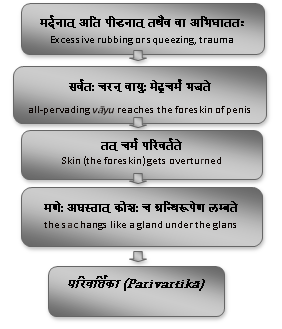
48. पलितः (Palitaḥ)
The text
क्रोध-शोक-श्रमकृतः शरीरोष्मा शिरोगतः।
पित्तं च केशान् पचति पलितं तेन जायते॥ (क्षुद्ररोगनिदानम् ३२)
Easy Sanskrit meaning –
क्रोधशोकश्रमकृतः, शरीरोष्मा पित्तं च शिरोगतः केशान् पचति, तेन पलितं जायते।
English meaning : on account ofanger, grief and physical exertion, the uṣmā of the body reaches to the head and vitiating the local pitta causes (premature) graying of hairs; palita is thus manifested .
Flow chart-
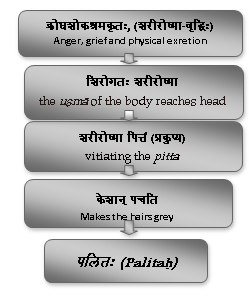
49.पूतिनस्यः(Pūtinasyaḥ)
The text
दोषैर्विदग्धैर्गल-तालुमूले सम्मूर्च्छितो यस्य समीरणस्तु।
निरेति पूतिर्मुखनासिकाभ्यां तं पूतिनस्यं प्रवदन्ति रोगम्॥ (नासारोगनिदानम् २)
Easy English meaning –
यस्य गलतालुमूले विदग्धै: दोषै: संमूर्च्छित: समीरण: पूति: मुखनासिकाभ्यां निरेति, तं रोगं पूतिनस्यं प्रवदन्ति।
English meaning : the vitiated doṣāḥ afflict the śvāsa (breath) in the throat and the tālumūla and propel it out of the mouth and the nose with a foul odour; the condition is known as pūtinasya
Flow chart-
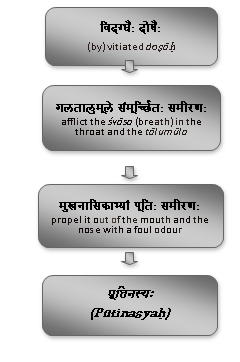
50. प्रतिश्यायः (Pratiśyāyaḥ)
The text
सन्धारणाजीर्णरजोऽतिभाष्य-क्रोधर्तुवैषम्य-शिरोभितापैः।
प्रजागरातिस्वपनाम्बु-शीतैरवश्यया मैथुन-बाष्प-धूमैः।
संस्त्यानदोषे शिरसि प्रवृद्धो वायुः प्रतिश्यायमुदीरयेत्तु॥
चयं गता मूर्धनि मारुतादयः पृथक् समस्ताश्च तथैव शोणितम्।
प्रकुप्यमाणा विविधैः प्रकोपणैस्ततः प्रतिश्यायकरा भवन्ति हि॥ (नासारोगनिदानम् १३-१४)
Easy Sanskrit meaning (anvaya)-
संधारणाजीर्णरजोऽतिभाष्यक्रोधर्तुवैषम्यशिरोभितापैः, प्रजागरातिस्वपनाम्बुशीतै:, अवश्यया, मैथुनबाष्पधूमैः (च) संस्त्यानदोषे शिरसि प्रवृद्ध: वायुः तु प्रतिश्यायम् उदीरयेत् । पृथक् समस्ता: च मारुतादयः तथैव शोणितं च मूर्धनि चयं गता: विविधैः प्रकोपणै: प्रकुप्यमाणा: ततः हि प्रतिश्यायकरा: भवन्ति।
English meaning : Vāyu, vitiated due to suppression of the natural urges, indigestion, dust, excessive talking, anger, unusual seasonal changes, headache, keeping awake at nights, excessive sleep, use of cold water, exposure to dew, excessive sexual intercourse and exposure to vapours or smoke, in the head, the site of the viscid dosa (i. e. kapha ), produces pratiśyāyaḥ. other doṣāḥ (i. e. pitta and kapha), individually or in combination and also rakta, vitiated due to their
respective aggravating factors, accumulate in the head and become a initiator of pratiśyāyaḥ.
Flow chart-
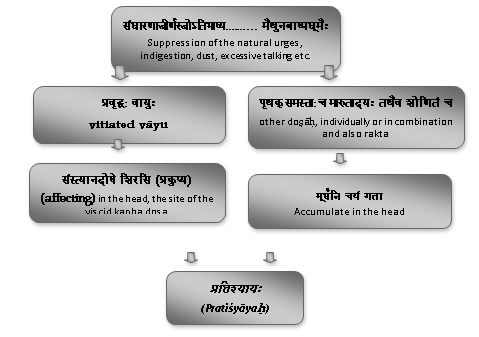
51. प्रतिनाहः (Pratīnāhaḥ)
The text
उच्छ्वासमार्गं तु कफः सवातो रुन्ध्यात् प्रतीनाहमुदाहरेत्तम्। (नासारोगनिदानम् ९)
Easy Sanskrit meaning : - सवात: कफ: तु उच्छ्वासमार्गं रुन्ध्यात्, तं प्रतीनाहम् उदाहरेत्।
English meaning :
When kapha, associated with vāta blocks the respiratory passage, the condition is called pratināhaḥ.
Flow chart-
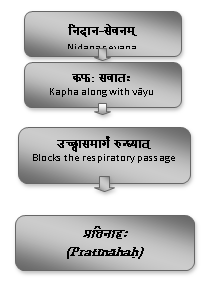
52. प्रमेहः (Pramēhaḥ)
The text
मेदश्च मांसं च शरीरजं च क्लेदं कफो बस्तिगतः प्रदूष्य।
करोति मेहान् समुदीर्णमुष्णैस्तानेव पित्तं परिदूष्य चापि॥
क्षीणेषु दोषेष्ववकृष्य धातून् संदूष्य मेहान् कुरुतेऽनिलश्च। (प्रमेहनिदानम् १-३,६)
Easy Sanskrit meaning (anvaya)-
बस्तिगतः कफ: शरीरजं मेद: मांसं क्लेदं च प्रदूष्य मेहान् करोति, उष्णै: समुदीर्णं पित्तं च अपि तान् एव परिदूष्य (मेहान् करोति), अनिल: च दोषेषु क्षीणेषु (सत्षु) धातून् संदूष्य अवकृष्य (च) मेहान् कुरुते।
English meaning :
(Vitiated)kapha located in the basti afflicting the meda, māṁsa and kleda produces prameha of the kaphaja variety. Similarly, pitta (located in the bladder ), vitiated by the use of articles having hot quality, afflicting the same ( meda, etc. ) causes the paittika prameha. (in due course) doṣa (kapha and pitta) get depleted, the (exacerbated) vāyu vitiating the dhatu (meda, etc.) and passes them out (with the urine) and produces prameha of the vātaja variety.
Flow chart-
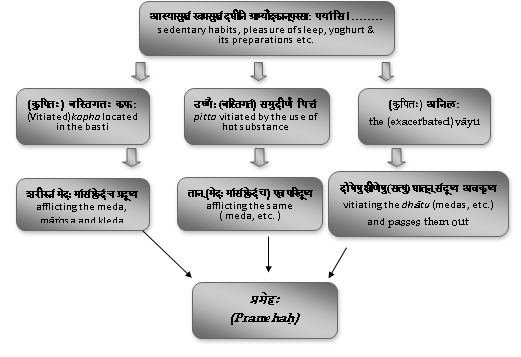
53.बाधिर्यम् (Bādhiryam)
The text
यदा शब्दवहं वायुः स्रोत आवृत्य तिष्ठति।
शुद्धः श्लेष्मान्वितो वाऽपि बाधिर्यं तेन जायते॥ (कर्णरोगनिदानम् ३)
Easy Sanskrit meaning (anvaya)-
यदा शुद्धः श्लेष्मान्वित: वा अपि वायु: शब्दवहं स्रोत: आवृत्य तिष्ठति, (तदा) तेन बाधिर्यं जायते।
English meaning :
When (vitiated) vāyu alone, or with kapha, gets lodged in śabdavaha-srotaḥ and blocks the same (sound-carrying channels of the ear), the disease bādhirya is produced.
Flow chart-
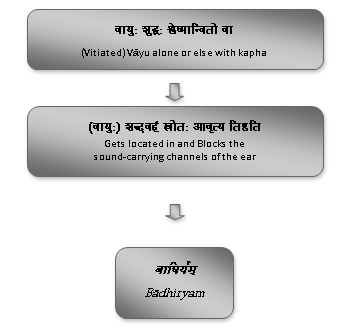
54. बाह्यायामः (Bāhyāyāmaḥ)
The text
बाह्यस्नायुप्रतानस्थो बाह्यायामं करोति च॥
तमसाध्यं बुधाः प्राहु-र्वक्षः-कट्यूरुभञ्जनम्। (वातव्याधिनिदानम् ३४-३५)
Easy Sanskrit meaning (anvaya)-
बाह्यस्नायुप्रतानस्थ: (कुपित: अनिल:) बाह्यायामं वक्षःकट्यूरुभञ्जनं च करोति, तं बुधाः असाध्यं प्राहु:।
English meaning :[3]
(when the vitiated vāyu) afflicts the bāhysnāyu (muscles and tendons), it bends the body dorsally. It may characterized with the fractures of the chest, the pelvis and the thighs ; (this is known as bāhyāyama) the experts consider it to be incurable.
Flow chart-
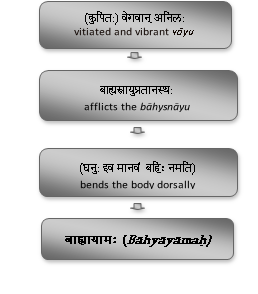
55. मसूरिका (masūrikā)
The text
कट्वम्ल-लवण-क्षारविरुद्धाध्यशनाशनैः।दुष्ट-निष्पाव-शाकाद्यैः प्रदुष्टपवनोदकैः॥
क्रूरग्रहेक्षणाच्चापि देशे दोषाः समुद्धताः। जनयन्ति शरीरेऽस्मिन् दुष्टरक्तेन सङ्गताः॥
मसूराकृतिसंस्थानाः पिडकाः स्युर्मसूरिकाः। (मसूरिकानिदानम् १-२)
Easy Sanskrit meaning (anvaya)-
कट्वम्ललवणक्षारविरुद्धाध्यशनाशनैः, दुष्टनिष्पावशाकाद्यैः, प्रदुष्टपवनोदकैः क्रूरग्रहेक्षणात् च अपि देशे समुद्धताः दोषाः दुष्टरक्तेन सङ्गताः अस्मिन् शरीरे मसूराकृतिसंस्थानाः पिडकाः जनयन्ति,(ता:) मसूरिकाः स्यु:।
English meaning :
Intake of pungent, sour, salty, alkaline and incompatible food, eating before the digestion of previous meal, consumption of decaying cereals and vegetables etc., air and water pollution, and also the influence of the wicked planets aggravate the doṣāḥ in the specific locality; the doṣāḥ, in association with the vitiated rakta produce eruptions resembling the seeds of masūra in the body. This condition is called masūrikā.
Flow chart-
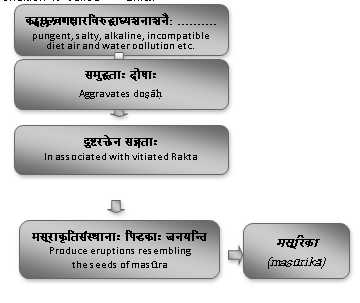
56. मूकाद्यवस्थाः (Mūkādyavasthāḥ)
The text
आवृत्य वायुः सकफो धमनीः शब्दवाहिनीः॥
नरान् करोत्यक्रियकान्मूक-मिन्मिन-गद्गदान्। (वातव्याधिनिदानम् ६५)
Easy Sanskrit meaning (anvaya)-
सकफ: (कुपित:) वायु: शब्दवाहिनीः धमनीः आवृत्य नरान् अक्रियकान् मूकमिन्मिनगद्गदान् (च) करोति।
English meaning : Vitiated vāyu along with kapha blocking up the speech-carrying channels disables the person and produces aphasia, nasal twang and stammering.
Flow chart-
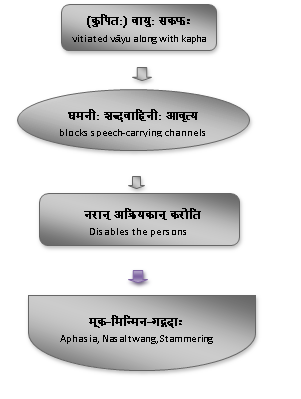
57. मूत्रकृच्छ्रम् (Mūtrakṛcchram)
The text
व्यायाम-तीक्ष्णौषध-रूक्ष-मद्यप्रसङ्ग-नित्यद्रुतपृष्ठयानात्।
आनूपमांसाध्यशनादजीर्णात्स्युर्मूत्रकृच्छ्राणि नॄणां तथाष्टौ॥
पृथङ्मलाः स्वैः कुपिता निदानैः सर्वेऽथवा कोपमुपेत्य बस्तौ।
मूत्रस्य मार्गं परिपीडयन्ति यदा तदा मूत्रयतीह कृच्छ्रात्॥ (मूत्रकृच्छ्रनिदानम् १-२)
Easy Sanskrit meaning (anvaya)-
व्यायामतीक्ष्णौषधरूक्षमद्यप्रसङ्गनित्यद्रुतपृष्ठयानात्, आनूपमांसाध्यशनात् अजीर्णात् च नॄणाम् अष्टौ मुत्रकृच्छ्राणि स्यु:। यदा स्वैः निदानैः कुपिता: मला: पृथक् अथवा सर्वे बस्तौ कोपमुपेत्य मूत्रस्य मार्गं परिपीडयन्ति, तदा इह कृच्छ्रात् मूत्रयति।
English meaning :
Excessive physical exercise, irritant drugs, dry (non-unctous) food, excessive drinking, riding on fast moving animals (or conveyances) daily, consumption of meat of swampy animals, eating before digestion of previous meal and indigestion lead to the eight types of mūtrakṛcchra in the human.
The doṣāḥ, individually or in combination, get vitiated on account of their specific exciting factors (as mentioned) and arriving the 'bladder afflict the mūtramārga (urinary passage); the patient passes urine with difficulty.
Flow chart-
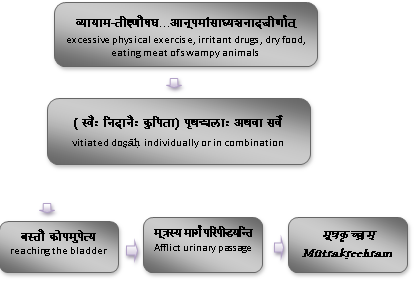
58. मूत्रक्षयः (Mūtrakṣayaḥ)
The text
रूक्षस्य क्लान्तदेहस्य बस्तिस्थौ पित्त-मारुतौ।
मूत्रक्षयं सरुग्दाहं जनयेतां तदाह्वयम् ॥ (मूत्राघातनिदानम् १२)
Easy Sanskrit meaning (anvaya)-
रूक्षस्य क्लान्तदेहस्य बस्तिस्थौ पित्तमारुतौ सरुग्दाहं मूत्रक्षयं तदाह्वयं जनयेताम्।
English meaning : (Vitiated) pitta and vāta situated in vasti of a dehydrated or an exhausted persons produce oliguria associated with pain and burning; this condition is known as mūtrakṣaya.
Flow chart-
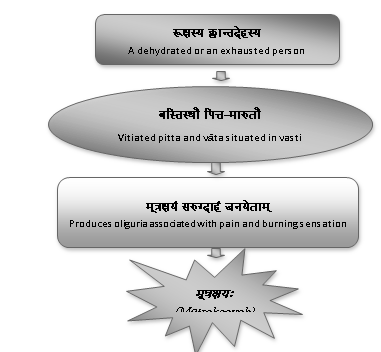
59.मूत्रजठरः (Mūtrajaṭharaḥ)
The text
मूत्रस्य वेगेऽभिहते तदुदावर्तहेतुकः। अपानः कुपितो वायुरुदरं पूरयेद्भृशम्॥
नाभेरधस्तादाध्मानं जनयेत्तीव्रवेदनम्। तन्मूत्रजठरं विद्यादधोबस्तिनिरोधनम॥
(मूत्राघातनिदानम् ८-९)
Easy Sanskrit meaning (anvaya)-
मूत्रस्य वेगे अभिहते तदुदावर्तहेतुकःकुपित: अपानः वायु: भ`शम् उदरं पूरयेत्, नाभे: अधस्तात् (च) तीव्रवेदनम् आध्मानं जनयेत्, अधोबस्तिनिरोधजं तं मूत्रजठरं विद्यात्|
English meaning :
Vitiated apāna-vāyu due to suppression of the urge of urination causes distension of the abdomen due to an excessive gaseous collection. The abdominal distension below the umbilical region results severe pain. This bladder outlet obstruction is known as mūtrajaṭhara.
Flow chart-
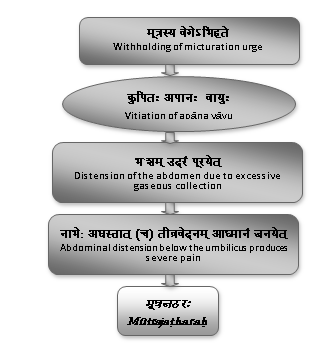
60. मूत्रशुक्रम् (Mūtraśukram)
The text
मूत्रितस्य स्त्रियं यातो वायुना शुक्रमुद्धतम्। स्थानाच्युतं मूत्रयतः प्राक् पश्चाद्वा प्रवर्तते॥
भस्मोदकप्रतीकाशं मूत्रशुक्रं तदुच्यते। (मूत्राघातनिदानम् १४)
Easy Sanskrit meaning (anvaya)-
मूत्रितस्य स्त्रियं यात: वायुना उद्धतं शुक्रं स्थानात् च्युतं मूत्रयतः प्राक् पश्चात् वा प्रवर्तते। भस्मोदकप्रतीकाशं तत् मूत्रशुक्रम् उच्यते।
English meaning :
When a person, having the urge for micturition indulges in sexual intercourse with a woman, his vāyu becomes vitiated and extricates śukra from its normal site. As a result Śukra, appears like lime water, comes out either before or after urination; the condition is known as mūtraśukra.
Flow chart-
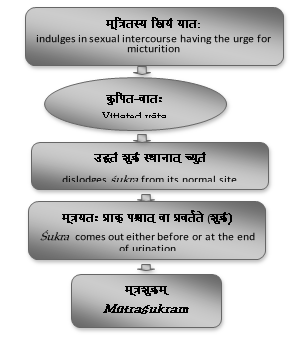
61. मूत्रसादः (Mūtrasādaḥ)
The text
पित्तं कफो द्वावपि वा संहन्येतेऽनिलेन चेत्॥कृच्छ्रान्मूत्रं तदा पीतं श्वेतं रक्तं घनं सृजेत्।
सदाहं रोचना-शङ्ख-चूर्णवर्णं भवेत्तु तत्।शुष्कं समस्तवर्णं वा मूत्रसादं वदन्ति तम्।
(मूत्राघातनिदानम् १७-१९)
Easy Sanskrit meaning (anvaya)-
चेत् पित्तं कफ: वा द्वौ अपि वा अनिलेन संहन्येते तदा कृच्छ्रात् पीतं श्वेतं रक्तं घनं च मूत्र सृजेत्।तत् तु सदाहं रोचनाशङ्खचूर्णवर्णं शुष्कं समस्तवर्णं वा भवेत्, तं मूत्रसादं वदन्ति।
English meaning :
On account of (vitiated) vāyu, when pitta and or kapha becomesolidified the person passes viscid urine of yellow, white or red colour with difficulty and burning sensation. The urine resembles the colour of rocanā (cow dung)or conch-shell powder and (ultimately) it may attain any colour. This condition is known as mūtrasāda.
Flow chart-

62. मूत्रोत्सङ्गः(Mūtrotsaṅgaḥ)
The text
बस्तौवाऽप्यथवानालेमणौवायस्यदेहिनः।मूत्रंप्रवृत्तंसज्जेतसरक्तंवाप्रवाहतः॥
स्रवेच्छनैरल्पमल्पंसरुजंवाऽथनीरुजम्।विगुणानिलजोव्याधिःसमूत्रोत्सङ्गसंज्ञितः॥
(मूत्राघातनिदानम् १०-११)
Easy Sanskrit meaning (anvaya)-
यस्य देहिनः प्रवृत्तं मूत्रं बस्तौ वा नाले अथवा मणौ वा प्रवाहतः अपि सरक्तं सज्जेत वा, शनै:अल्पम् अल्पं सरुजं नीरुजं वा स्रवेत्, विगुणानिलज: स: व्याधिः मूत्रोत्सङ्गसंज्ञितः।
English meaning :
When, in a person, the flow of urine gets obstructed at the level of basti (the bladder), nāla (the urethra) and or maṇi (the glans) and if on straining, it dribbles slowly with blood or is passed in small quantity, with or without pain, the disease is, known as mutrotsaṅga and is caused by the vitiation of vāta.
Flow chart-
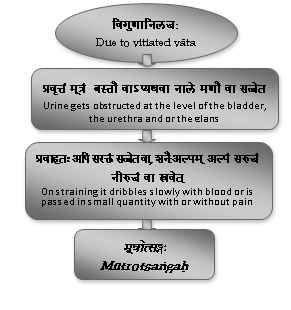
63.मूर्च्छा (Mūrcchā)
The text
क्षीणस्य बहुदोषस्य विरुद्धाहारसेविनः। वेगाघातादभिघाताद्धीनसत्त्वस्य वा पुनः॥
करणायतनेषूग्रा बाह्येष्वाभ्यन्तरेषु च। निविशन्ते यदा दोषा-स्तदा मूर्च्छन्ति मानवाः॥
संज्ञावहासु नाडीषु पिहितास्वनिलादिभिः। तमोऽभ्युपैति सहसा सुखदुःखव्यपोहकृत्॥
सुखदुःखव्यपोहाच्च नरः पतति काष्ठवत्। मोहो मूर्च्छेति तामाहुः ...... ॥
(मूर्च्छाभ्रमनिद्रा-तन्द्रासंन्यास –निदानम् १-४ )
Easy Sanskrit meaning (anvaya)-
क्षीणस्य, बहुदोषस्य, विरुद्धाहारसेविनः, पुन: वेगाघातात् अभिघाताद् वा हीनसत्त्वस्य, बाह्येषु आभ्यन्तरेषु च करणायतनेषु यदा उग्रा: दोषा: निविशन्ते तदा मानवाः मूर्च्छन्ति।अनिलादिभिः (दोषै:) पिहिताः संज्ञावहासु नाडीषु सहसा सुखदुःखव्यपोहकृत् तम: अभ्युपैति, सुखदुःखव्यपोहात् च नरः काष्ठवत् पतति तं मोह: मूर्च्छा (वा) इति आहुः।
English meaning :
When the doṣāḥ, aggarved by the suppression of the natural urges and trauma inpersons who are emaciated, who have an excess of doṣāḥ and who take incompatible diet, particularly in those who are mentally weak, involve both the external and internal perceptive apparatus then human being gets mūrcchā. When the sajñāvahānāḍī get obstructed by vitiated vāyu and other doṣa there is a sudden augmentation in ,tamoguṇa which leads to a loss of awareness for pleasure or pain. As a result of the absence of the perception of delight or woe the patient falls (unconscious) like a log of wood. This condition is known as moha or mūrcchā.
Flow chart-
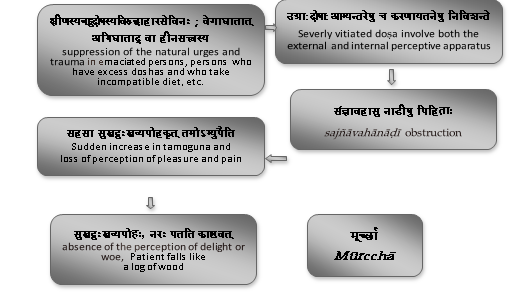
64. मृत्तिकाभक्षणजन्यपाण्डुः (Mṛttikābhakṣaṇajanyapāṇḍuḥ)
The text
मृत्तिकादनशीलस्य कुप्यत्यन्यतमो मलः। कषाया मारुतं पित्त-मूषरा मधुरा कफम्॥
कोपयेन्मृद्रसादींश्च रौक्ष्याद्भुक्तं च रूक्षयेत्। पूरयत्यविपक्वैव स्रोतांसि निरुणध्द्यपि॥
इन्द्रियाणां बलं हत्वा तेजो वीर्यौजसी तथा। पाण्डुरोगं करोत्याशु बल-वर्णाग्निनाशनम्॥
(पाण्डुरोगकामलाकुम्भकामलादि- निदानम्/२ )
Easy Sanskrit meaning (anvaya)-
मृत्तिकादनशीलस्य (पुरुषस्य) अन्यतम: मल: कुप्यति, (यथा) कषाया (मृत्तिका) मारुतम्, ऊषरा पित्त, मधुरा च कफं कोपयेत् । मृद् रौक्ष्यात् भुक्तं रसादीन् च रूक्षयेत् । अविपक्वा एव स्रोतांसि पूरयति, निरुणद्धि अपि। इन्द्रियाणां बलं तेज: तथा वीर्यौजसी हत्वा बलवर्णाग्निनाशनं पाण्डुरोगम् आशु करोति।
English meaning :
A person used to eating earth cakes, one of his humors (doṣāḥ) getvitiated, such as the astringent earth vitiates vāta, the alkaline earth vitiated pitta and the sweet earth vitiated kapha. On account of its dryness, the earth, dries up the rasa and other dhātu and also the ingested food which, in turn, remaining undigested, occupies and obstructs the srotas. This impeds the power of indriya (the organs of perception and action) and also the lustre, potency and ojas, thereby producing Pāṇḍu-rogaḥ which annihilates strength, colour and digestive power of the patient.
Flow chart-
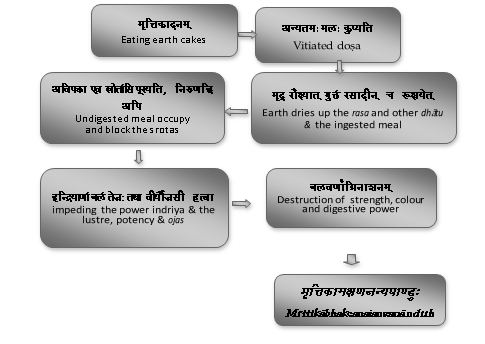
65. मेदोरोगः (Medarōgaḥ)
The text
अव्यायाम-दिवास्वप्नश्लेष्मलाहारसेविनः।मधुरोऽन्नरसः प्रायः स्नेहान्मेदः प्रवर्धयेत्॥
मेदसाऽऽवृतमार्गत्वात् पुष्यन्त्यन्ये न धातवः। मेदस्तु चीयते ... (मेदोरोग-निदानम् १-२)
Easy Sanskrit meaning (anvaya)-
अव्यायामदिवास्वप्नश्लेष्मलाहारसेविनः अन्नरसः मधुर: प्रायः स्नेहाद् मेदः प्रवर्धयेत्।मेदसा आवृतमार्गत्वात् अन्ये धातव: न पुष्यन्ति, तु मेद: चीयते।
English meaning :
The food substance generally get converted into sneha dravya in person who does no physical exercise, enjoying daysleep and taking kapha-provoking;diet, sweet substances which, in turn, leads' to increase in the fat. Subsequently other dhātu do not get properly nourished in him because of the channels 'being obstructed with meda. As a result there is accumulation of meda.
Flow chart-
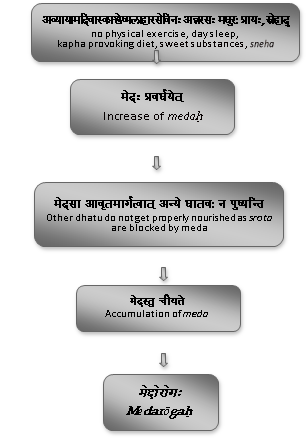
66. रक्तगुल्मः (Raktagulmaḥ)
The text
नवप्रसूताऽहितभोजना या या चामगर्भं विसृजेदृतौ वा।
वायुर्हि तस्याः परिगृह्य रक्तं करोति गुल्मं सरुजं सदाहम्। (गुल्म-निदानम् १-२)
Easy Sanskrit meaning (anvaya)-
नवप्रसूता या आमगर्भं विसृजेत् ऋतौ वा अहितभोजना तस्याः वायु: हि रक्तं परिगृह्य सरुजं सदाहं गुल्मं करोति। ।
English meaning : Indulgence in unsalutary diet by women during early puerperium, after an abortion of early pregnancy or during the menses causes vitiation of vāyu which, in turn, afflicting the (menstrual) blood produces a gulma (mass like) associatedwith burning sensation and pain.
Flow chart-
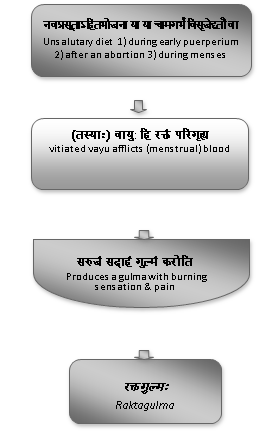
67. रक्तपित्तम् (Raktapittam)
The text
घर्म-व्यायाम-शोकाध्वव्यवायैरतिसेवितैः।तीक्ष्णोष्ण-क्षार-लवणैरम्लैः कटुभिरेव च॥
पित्तं विदग्धं स्वगुणैर्विदहत्याशु शोणितम्। ततः प्रवर्तते रक्तमूर्ध्वं चाधो द्विधाऽपि वा॥
(रक्तपित्त-निदानम् १-३)
Easy Sanskrit meaning (anvaya)-
घर्मव्यायामशोकाध्वव्यवायै: अतिसेवितैः तीक्ष्णोष्णक्षारलवणै:, अम्लैः कटुभि: एव च विदग्धं पित्तं स्वगुणै: शोणितम् अपि आशु विदहति। तत: रक्तम् अर्ध्वम् अध: च द्विधा अपि वा प्रवर्तते।
English meaning : (the pitta gets vitiated) by over exposure to the sun, excessive physical exercise, grief, walking long distances and sexual intercourse, and excessive intake of tīkṣṇa, hot, kṣāra, saltish, acidic and pungent substances. On account of its inherent (similar) qualities, vitiated pitta quickly afflicts the blood; subsequently, the blood is passed either through the upper (outward srotas) routes, or by the lower routes and by both also.
Flow chart-
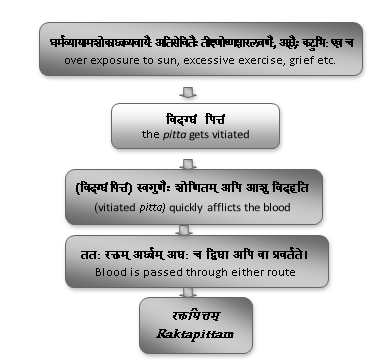
68. राजयक्ष्मा/शोषः (Rājayakṣmā)/śoṣa
The text
वेगरोधात्क्षयाच्चैवसाहसाद्विषमाशनात्।त्रिदोषोजायतेयक्ष्मागदोहेतुचतुष्टयात्॥ (राजयक्ष्मा-निदानम् १-२ )
कफप्रधानैर्दोषैस्तुरुद्धेषुरसवर्त्मसु। अतिव्यवायिनोवाऽपिक्षीणेरेतस्यनन्तराः।
क्षीयन्तेधातवःसर्वेततःशुष्यतिमानवः॥ (राजयक्ष्मा-निदानम् ५-७ )
Easy Sanskrit meaning (anvaya)-
वेगरोधात्, क्षयात् , साहसात् विषमाशनात् च (इति) हेतुचतुष्टयात् एव त्रिदोष: यक्ष्मा, गद: जायते। ………….. कफप्रधानै: र्दोषै: तु रसवर्त्मसु रुद्धेषु (सत्सु) अनन्तराः अतिव्यवायिन: वा अपि, रेतसि क्षीणे सर्वे धातवः क्षीयन्ते, ततः (च) मानवः शुष्यति।
English meaning:
(Habitual) suppression of the natural urges, excessive loss of vigor, working beyond capacity and improper food are the four causative factors of the disease (rāja) yakṣmā which originates due to vitiation of (all) the three doṣāḥ.
वेगरोधात्, क्षयात् , साहसात् विषमाशनात् suppression of the natural urges, excessive loss of vigour, working beyond capacity etc |
Obstruction of the rasavahasrota predominantly by the kapha doṣa (tridoṣā) and on the other wayexcessive sexual intercourse and excessive loss of semen lead to the depletion of all the dhātu; thus the human develops śoṣa (consumption).
Flow chart-
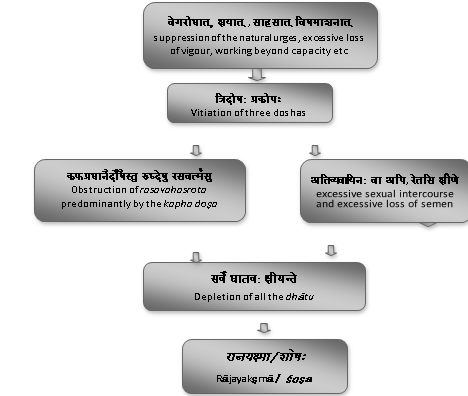
69. बस्तिकुण्डलः (Bastikuṇḍalaḥ)
The text
द्रुताध्वलङ्घनायासैरभिघातात् प्रपीडनात्। स्वस्थानाद्बस्तिरुद्धृत्तः स्थूलस्तिष्ठति गर्भवत्॥
शूल-स्पन्दन-दाहार्तो बिन्दुं बिन्दुं स्रवत्यपि।पीडितस्तु सृजेद्धारां संस्तम्भोद्वेष्टनार्तिमान्॥
बस्तिकुण्डलमाहुस्तं घोरं शस्त्र-विषोपमम्। पवनप्रबलं प्रायो ..........।
(मूत्रघात- निदानम् २१-२३)
Easy Sanskrit meaning (anvaya)-
द्रुताध्वलङ्घनायासै:, अभिघातात् प्रपीडनात स्वस्थानात् वस्ति: उद्धृत्तः गर्भवत् स्थूल: तिष्ठति। शूलस्पन्दनदाहार्त: बिन्दुं बिन्दुं स्रवति अपि, पीडित: संस्तम्भोद्वेष्टनार्तिमान् धारां सृजेत्, तं शस्त्रविषोपमम् घोरं बस्तिकुण्डलम् आहु:। प्राय: पवनप्रबलं ... ।
English meaning : on account of rapid walking , jumping, excessive physical exercise, trauma or compression, the bladder gets pushed upwards (by vitiated vāyu) and remains as a big mass like a foetus. the patient suffers with griping pain, twitching and burning sensations and passes urine drop by drop. On pressure, the bladder evacuates urine in a stream. The patient feels stiffness and cramp like pain. It is known as bastikuṇḍala, has predominance of vāyu .
Flow chart-
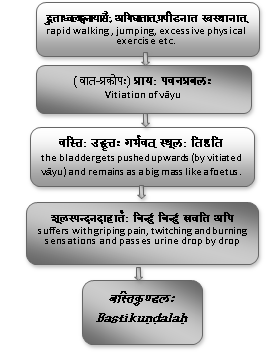
70. वातकुण्डलिका (vātakuṇḍalikā)
The text
रौक्ष्याद्वेगविघाताद्वा वायुर्बस्तौ सवेदनः।मूत्रमाविश्य चरति विगुणः कुण्डलीकृतः॥
मूत्रमल्पाल्पमथवा सरुजं सम्प्रवर्तते। (मूत्रघात- निदानम् २-३)
Easy Sanskrit meaning (anvaya)-
रौक्ष्यात् वेगविघाताद् वा विगुणः वायु: वस्तौ मूत्रम् आविश्य सवेदनः कुण्डलीकृतः चरति। मूत्रम् अल्पाल्पम् अथवा सरुजं प्रवर्तते, तां सुदारुणं व्याधिं तु वातकुण्डलिकां विद्यात्।
English meaning : Due to (excessive intake of) dry food or suppression of the natural urges, vāyu located in basti, gets vitiated and getting mixed up with the urine moves around like a reel associated with pain. The patient either passes very small amount of urine or with pain. The condition is called vātakuṇḍalikā which is a very grave disease.
Flow chart-
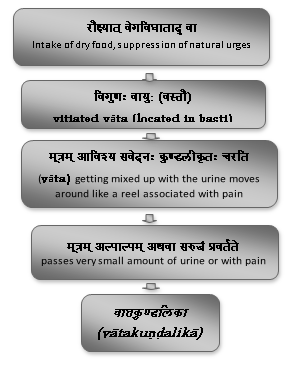
71. वातबस्तिः (Vātabastiḥ)
The text
वेगं विधारयेद्यस्तु मूत्रस्याकुशलो नरः। निरुणद्धि मुखं तस्य बस्तेर्बस्तिगतोऽनिलः॥
मूत्रसङ्गो भवेत्तेन बस्ति-कुक्षिनिपीडीतः। वातबस्तिः स विज्ञेयो व्याधिः कृच्छ्रप्रसाधनः॥
(मूत्रघात- निदानम् ६-८)
Easy Sanskrit meaning (anvaya)-
य: तु वेगं अकुशल: नर: मूत्रस्य वेगं विधारयेत्, तस्य बस्तिगत: अनिल: बस्ते: मुखं निरुणद्धि। तेन मूत्रसङ्ग: भवेत्, बस्तिकुक्षिनिपीडीतः (च भवेत्)।स: कृच्छ्रप्रसाधनः व्याधिः वातबस्तिः विज्ञेय: ।
English meaning : When an unwise person suppresses the urge of micturition vāyu obstructs the vesicular outlet leading to retention of urine along with pain in the bladder and the abdomen. This condition is known as vātabasti and is curable with difficulty.
Flow chart-
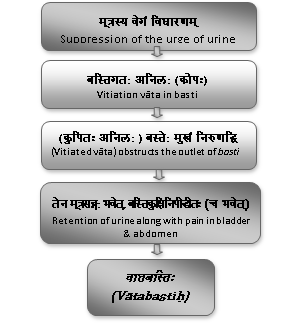
72. वातव्याधिः (Vātavyādhiḥ)
The text
रुक्ष-शीताल्प-लघ्वन्न-व्यवायातिप्रजागरैः। विषमादुपचाराच्च दोषासृक्स्रवणादपि ॥
लङ्घन-प्लवनात्यध्व-व्यायामादिविचेष्टितैः। धातूनां संक्षयाच्चिन्ता-शोक-रोगातिकर्षणात्॥
वेगसन्धारणादामादभिघातादभोजनात् । मर्माबाधाद्गजोष्ट्राश्वशीघ्रयानापतंसनात्॥
देहे स्रोतांसि रिक्तानि पूरयित्वाऽनिलो बली । करोति विविधान् व्याधीन् सर्वाङ्गैकाङ्गसंश्रयान् ॥
(वातव्याधि-निदानम्/१-४ )
Easy Sanskrit meaning (anvaya)-
रुक्षशीताल्पलघ्वन्नव्यवायातिप्रजागरैः, विषमाद् अपचारात् दोषासृक्स्रवणात् अपि, लङ्घनप्लवनात्यध्वव्यायामादिविचेष्टितैः, धातूनां संक्षयात् चिन्ताशोकरोगातिकर्षणात्, वेगसन्धारणात्, आमात्, अभिघातात् अभोजनात्, मर्माबाधात्, गजोष्ट्राश्वशीघ्रयानापतंसनात् च देहे बली अनिल: रिक्तानि स्रोतांसि पूरयित्वा विविधान् सर्वाङ्गैकाङ्गसंश्रयान् व्याधीन् करोति।
English meaning:
Dry (non-unctous), cold , in insufficient quantity and light food, excessive sexual intercourse, keeping awake at nights, inappropriate (pañcakarma and other) therapeutic measures, excessive loss of doṣa and of blood, laṅghana, excessive swimming, long walking, excessive physical exercise and similar exertions, depletion of dhātu , worry, grief, marked emaciation due to diseases, suppression of the natural urges, āma, trauma, fasting, injury to the vital parts, and (excessive) riding on elephant, camel, horse or on fast moving vehicle or else fall from them, exaggerate vāyu which, afflicting the emptied srotas of the body, produces various generalised diseases or localised to a part of the body.
Flow chart-
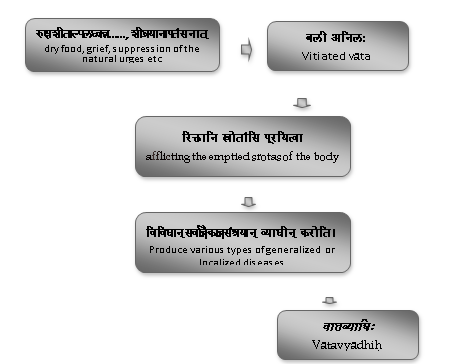
73.विड्विघातः (viḍvighātaḥ)
The text
रूक्ष-दुर्बलयोर्वाते, नोदावृत्तं शकृद्यदा॥मूत्रस्रोतोऽनुपद्येत, विट्संसृष्टं तदा नरः।
विड्गन्धं मूत्रयेत् कृच्छ्राद्विड्विघातं विनिर्दिशेत्॥ (मूत्रघात- निदानम् १९-२०)
Easy Sanskrit meaning (anvaya)-
रूक्षदुर्बलयो: शकृत् यदा वातेन उदावृत्तं मूत्रस्रोत: अनुपद्येत, तदा नर:विट्संसृष्टं विड्गन्धं कृच्छ्रात् मूत्रयेत्, (तं) विड्विघातं विनिर्दिशेत्।
English meaning : When the stool of a dehydrated and weak person travel upwards due to (vitiated) vāyu and reach the urinary passage, then the patient passes urine, of faecal odour mixed with stool with great difficulty. The state is known as viḍvighātaḥ.
Flow chart-
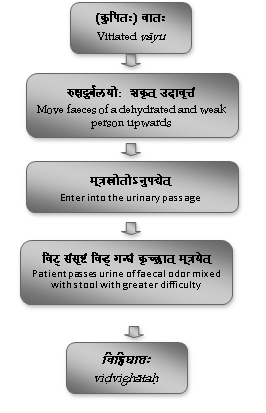
74. विद्रधिः (Vidradhiḥ)
The text
त्वग्रक्त-मांस-मेदांसि संदूष्यास्थिसमाश्रिताः।दोषाः शोथं शनैर्घोरं जनयन्त्युच्छ्रिता भृशम्॥
महामूलं रुजावन्तं वृत्तं वाऽप्यथवाऽऽयतम्।स विद्रधिरिति ख्यातो ...............॥
(विद्रधि- निदानम् १-३)
Easy Sanskrit meaning (anvaya)-
भृशम् उच्छ्रिता: दोषा: अस्थिसमाश्रिताः त्वग्रक्तमांसमेदांसि संदूष्या शनै: शनै: घोरं, महामूलं, रुजावन्तं, वृत्तम् आयतं वा शोथं जनयन्ति। स: विद्रधि: इति ख्यात:।
English meaning :
The extremely vitiated doṣāḥ lodged in the asthi (bones), afflict tvak (the skin), rakta (blood), māṁsa (muscles) and meda and slowly produce a severe, broad based, painful and round or elongated swelling and is considered as vidradhiḥ .
Flow chart-
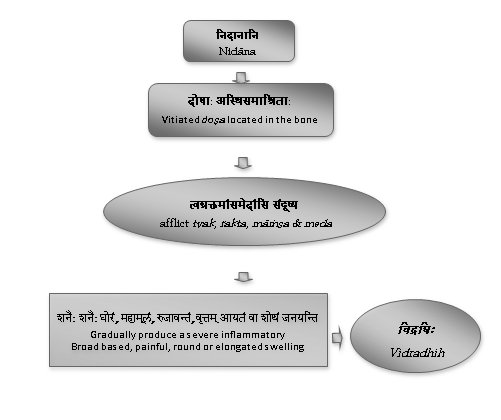
75. विलम्बिका (Vilambikā)
The text
दुष्टं तु भुक्तं कफ-मारुताभ्यां प्रवर्तते नोर्ध्वमधश्च यस्य।
विलम्बिकां तां भृशदुश्चिकित्स्या-माचक्षते शास्त्रविदः पुराणाः॥ ( अग्निमान्द्यादि- निदानम् २१)
Easy Sanskrit meaning (anvaya)-- यस्य कफमारुताभ्यां दुष्टं भुक्तं न ऊर्ध्वं (न) च अध: प्रवर्तते तां पुराणाः शास्त्रविदः भृशदुश्चिकित्स्यां विलम्बिकाम् आचक्षते।
English meaning : The situation in which the ingested food gets infected due to kapha and vāyu and the contents neither move upwards nor downwards is called as vilambikā whichexperienced and learned clinicians consider as very difficult to treat.
Flow chart-
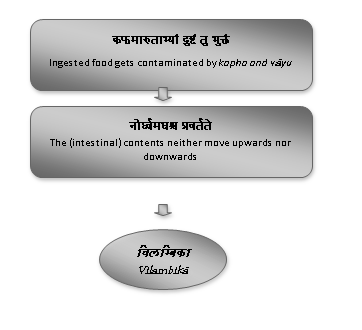
76. विषमज्वरः (Viṣamajvaraḥ)
The text
दोषोऽल्पोऽहितसम्भूतो ज्वरोत्सृष्टस्य वा पुनः॥धातुमन्यतमं प्राप्य करोति विषमज्वरम् । (ज्वर- निदानम् ३१)
Easy Sanskrit meaning –
अहितसम्भूत: अल्प: दोष: पुन: ज्वरोत्सृष्टस्य वा (अल्प: दोष:) अन्यतमं धातुं प्राप्य विषमज्वरं करोति।
English meaning :
In case if the vitiated doṣa is small in quantity or residual doṣa remains dormant of a newly recovered patient of jvara and if the same (doṣa) gets vitiated due to indulgence in unbeneficial (diet and behavioural) regimen, then it gets localized inthe various dhātu and produces the viṣamajvara.
Flow chart-
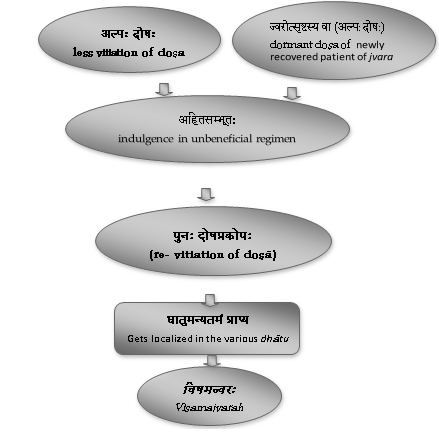
77. विसर्पः (Visarpaḥ)
The text
लवणाम्ल-कटूष्णादि-संसेवादोषकोपतः। विसर्पः सप्तधा ज्ञेयः सर्वतः परिसर्पणात्॥१॥
रक्तं लसीका त्वङ्मांसं दूष्यं दोषास्त्रयो मलाः॥४॥ विसर्पाणां समुत्पत्तौ विज्ञेयाः सप्त धातवः।
(विसर्प- निदानम्१,४)
Easy Sanskrit meaning –
लवणाम्लकटूष्णादिसंसेवादोषकोपतः सर्वतः परिसर्पणात् विसर्पः सप्तधा ज्ञेय:।… रक्तं लसीका त्वङ्मांसं दूष्यं त्रय: मला: दोषा: (च-एते) सप्त धातव: विसर्पाणां समुत्पत्तौ विज्ञेयाः।
English meaning : The doṣa vitiated due to the constant use of salty, sour, pungent and hot articles, etc. give rise to the seven types of visarpa ; ……rakta, lasikā, tvak and māṁsa : these susceptible dūṣya together with the three-doṣa are the seven factors which are accountable for the production of visarpa.
Flow chart-
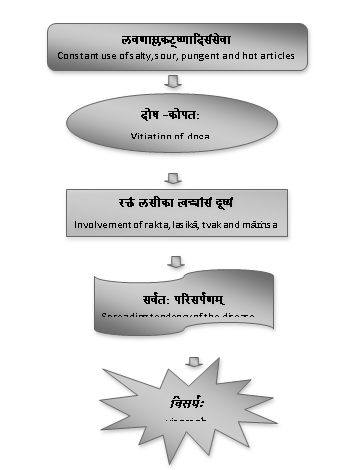
78. विस्फोटः (Visphōṭaḥ)
The text
कट्वम्ल-तीक्ष्णोष्ण-विदाहि-रूक्ष-क्षारैरजीर्णाध्यशनातपैश्च। तथर्तुदोषेण विपर्ययेण कुप्यन्ति दोषाः पवनादयस्तु॥
त्वचमाश्रित्य ते रक्तमांसास्थीनि प्रदूष्य च। घोरान् कुर्वन्ति विस्फोटान् सर्वान् ज्वरपुरःसरान्॥
(विस्फोट-निदानम् १,२)
Easy Sanskrit meaning (anvaya)-
कट्वम्लतीक्ष्णोष्णविदाहिरूक्षक्षारै:, अजीर्णाध्यशनातपै:, तथा ऋतुदोषेण विपर्ययेण च पवनादय: तु कुप्यन्ति। ते त्वचम् आश्रित्य रक्तमांसास्थीनि प्रदूष्य च ज्वरपुरःसरान् सर्वान् घोरान् विस्फोटान् कुर्वन्ति।
English meaning :
Vātādi doṣāḥ get vitiated by excessive intake of pungent, sour, sharp, hot, heartburn producing, dry (non-unctous) and alkaline substances, indigestion, eating before the previous meal has been digested, over-exposure to the sun and abnormal seasonal variations; these doṣāḥ getting lodged in the skin vitiate rakta, māṁsa and asthi and produce severe visphoṭa associated with jvara.
Flow chart-

79.वृद्धिः (Vṛddhiḥ)
The text
वृद्धाऽनूर्ध्वगतिर्वायुः शोथ-शूलकरश्चरन्। मुष्कौ वङ्क्षणतःप्राप्य फल-कोषाभिवाहिनीः॥
प्रपीड्य धमनीर्वृद्धिं करोति फल-कोषयोः। (वृद्धिनिदानम्-१-२)
Easy Sanskrit meaning (anvaya)-
अनूर्ध्वगति: वृद्धः वायुः शोथशूलकर: चरन् वङ्क्षणतः मुष्कौ प्राप्य फलकोषाभिवाहिनीः धमनी: प्रपीड्य फलकोषयोः वृद्धि: करोति ।
English meaning :
During the downward course, the aggravated vāyu reaches muṣka (the scrotum) through vaṅkhaṇa (the inguinal region), produces oedema and pain and subsequently afflicts the scrotal vessels and ( finally) causes enlargement of the scrotum.
Flow chart-
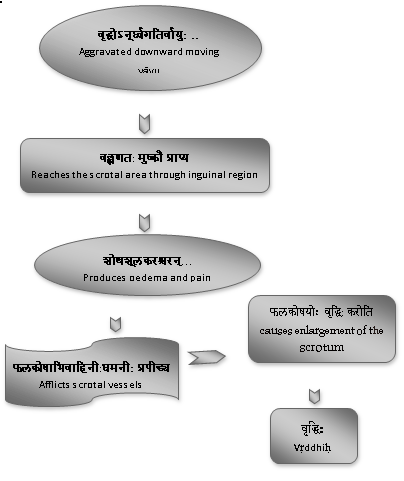
80. व्यङ्गम् (Vyaṅgam)
The text
क्रोधायासप्रकुपितो वायुः पित्तेन संयुतः। मुखमागत्य सहसा मण्डलं विसृजत्यतः॥
नीरुजं तनुकं श्यावं मुखे व्यङ्गं तमादिशेत्। कृष्णमेवंगुणं गात्रे मुखे वा नीलिकां विदुः॥
(क्षुद्ररोगनिदानम् ३९-४०)
Easy Sanskrit meaning (anvaya)-
क्रोधायासप्रकुपित: वायुः पित्तेन संयुतः मुखम् आगत्य सहसा मुखे नीरुजं तनुकं श्यावं मण्डलं विसृजति, अतः तं व्यङ्गम् आदिशेत्। एवं गुणं मुखे गात्रे वा कृष्णं (मण्डलं) नीलिकां विदुः।
English meaning : Vāyu, aggravated by anger and physical exertion, in association with pitta reaching the face, suddenly produces a painless, thin and grayish circular patch in face. This is known as vyaṅga. similar type of lesion on the face. or elsewhere in the body but black in colour, is known as nīlikā.
Flow chart-
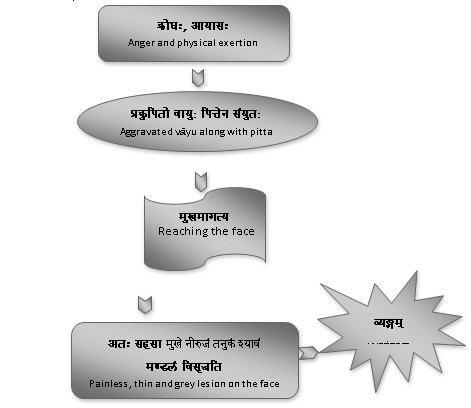
81. शर्करार्बुदः (Śarkarārbudaḥ)
The text
प्राप्य मांस-सिरा-स्नायुः श्लेष्मा मेदस्तथाऽनिलः। ग्रन्थिं करोत्यसौ भिन्नो मधु-सर्पिर्वसानिभम्॥
स्रवत्यास्रावमनिलस्तत्र वृद्धिं गतः पुनः। मांसं संशोष्य ग्रथितां शर्करां जनयेत्ततः॥
दुर्गन्धि क्लिन्नमत्यर्थं नानावर्णं ततः सिराः। स्रवन्ति रक्तं सहसा तं विद्याच्छर्करार्बुदम्॥
( क्षुद्ररोगनिदानम् २२-२४)
Easy Sanskrit meaning (anvaya)- श्लेष्मा, मेद:, तथा अनिलः मांससिरास्नायुः प्राप्य ग्रन्थिं करोति। असौ भिन्न:, मधुसर्पिर्वसानिभम् आस्रावं स्रवति। तत्र वृद्धिं गतः अनिल: पून: मांसं संशोष्य तत: ग्रथितां शर्करां जनयेत्।तत: सिरा: दुर्गन्धि अत्यर्थं क्लिन्नं नानावर्णं रक्तं सहसा स्रवन्ति, तं शर्करार्बुदं विद्यात्।
English meaning : The ( vitiated) kapha, meda and vāta getting lodged in the māṁsa, sirā and snāyu, produce a swelling (initially). (later on) After bursting, a discharge resembling honey, ghṛta or vasā, flows out (from the swelling). Subsequently, the vāta getting further increased locally dries up the māṁsa and produces knotted granular concretions. The lesion now emits a bad odour, becomes excessively sodden and suddenly flows out blood of variegated colours from the vessels. The condition is known as śarkarārbuda.
Flow chart-
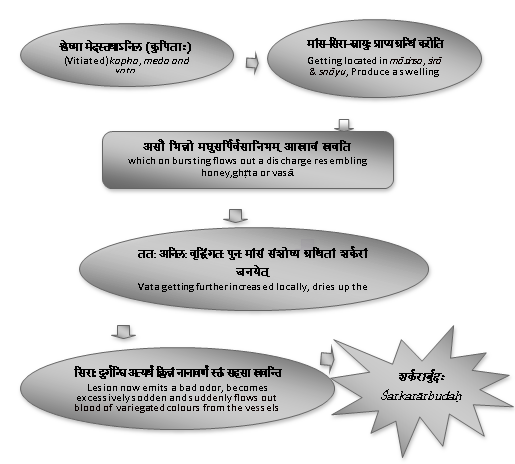
82. शीतपित्तम् (Śītapittam)
The text
शीतमारुतसंस्पर्शात् प्रदुष्टौ कफमारुतौ। पित्तेन सह सम्भूय बहिरन्तर्विसर्पतः॥(शीतपित्तनिदानम् १)
Easy Sanskrit meaning (anvaya)-
शीतमारुतसंस्पर्शात् कफमारुतौ प्रदुष्टौ पित्तेन सह सम्भूय बहि: अन्त: (च) विसर्पतः[रोगान् उत्पादयत:]।
English meaning :
On account of exposure to a cold wind, kapha and vāyu get vitiated, and combining with pitta and spread out internally and externally ( produce these (allergic) diseases in both surfaces).
Flow chart-
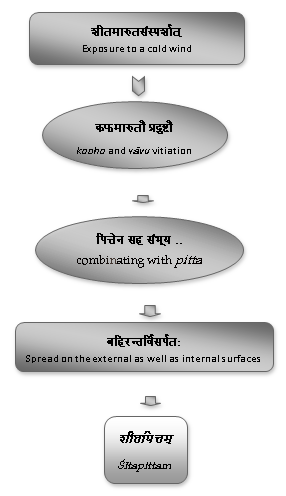
83.शोकजातिसारः (Śōkajātisāraḥ)
The text
तैस्तैर्भावैः शोचतोऽल्पाशनस्य बाष्पोष्मा वै वह्निमाविश्य जन्तोः।
कोष्ठं गत्वा क्षोभयेत्तस्य रक्तं तच्चाधस्तात् काकणन्तीप्रकाशम्॥
निर्गच्छेद्वै विड्विमिश्रं ह्यविड्वा निर्गन्धं वा गन्धवद्वाऽतिसारः ।
शोकोत्पन्नो दुश्चिकित्स्योऽतिमात्रं रोगो ......॥(अतिसारनिदानम् ९-१०)
Easy Sanskrit meaning (anvaya)— तैः तैः भावैः शोचतः अल्पाशनस्य जन्तोः बाष्पोष्मा वै वह्निम् आविश्य, कोष्ठं गत्वा तस्य रक्तं क्षोभयेत् , तच्चाधस्तात् वै काकणन्तीप्रकाशं विड्विमिश्रं ह्यविड्वा निर्गन्धं वा गन्धवद्वाऽतिसारः निर्गच्छेत् ।शोकोत्पन्नः अतिमात्रं दुश्चिकित्स्यः रोगः ......
English meaning : The person, in grief due to different causes, takes small quantities of meals; his vāṣpoṣmā affecting the digestive fire and reaching the alimentary tract afflicts the blood. Subsequently, this blood, looking like kākaṇantī, is passed by the patient from the lower passage (guda) mixed with stool or without faeces and with or without an odour. This atisāra due to grief etc is extremely difficult to treat.
Flow chart-
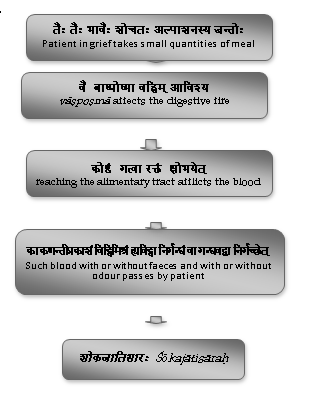
84. शोथः (Śōthaḥ)
The text
रक्त-पित्त-कफान् वायुर्दुष्टो दुष्टान् बहिः सिराः। नीत्वा रुद्धगतिस्तैर्हि कुर्यात्त्वङ्मांससंश्रयम्॥(शोथनिदानम् १)
Easy Sanskrit meaning (anvaya)-
दुष्ट: वायु: दुष्टान् रक्तपित्तकफान् बहि:सिराः नीत्वा तै: रुद्धगति: हि त्त्वङ्मांससंश्रयं निचयाद् उत्सेधं संहतं कुर्यात्, अत: तं शोथम्, आहु:।
English meaning :
Deranged vāyu carries the vitiated rakta, pitta and kapha to the peripheral vessels and the flow is stagnated and inlodging within tvak and māṁsa cause indurated and inflamed swelling. That is known as śothaḥ.
Flow chart-
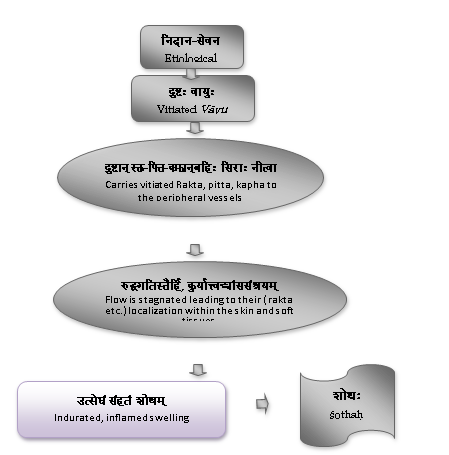
85. श्वासः (Śvāsaḥ)
The text
यदा स्रोतांसि संरुध्य मारुतः कफपूर्वकः।
विष्वग्व्रजति संरुद्ध-स्तदा श्वासान् करोति सः॥
(हिक्काश्वास-निदानम्/२ )
Easy Sanskrit meaning (anvaya)-
(निदानैः कुपितः) - कफपूर्वकः संरुध्य: मारुतः यदा स्रोतांसि संरुद्ध विष्वक् व्रजति तदा स: श्वासान् करोति।
English meaning :
When there is hindrance of the prāṇavahasrota (air passages) due to (vitiated) vāyu in association with kapha then there is an abnormal movement of vāyu and causes various kinds of śvāsarogaḥ .
Flow chart-
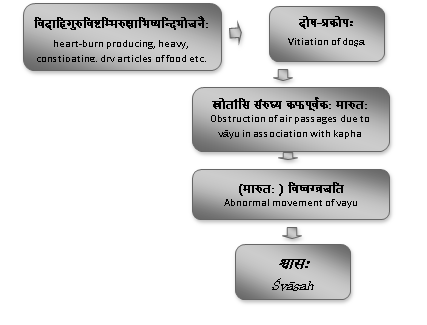
86. संन्यासः (Saṁnyāsaḥ)
The text
वाग्देह-मनसां चेष्टामाक्षिप्यातिबला मलाः। संन्यस्यन्त्यबलं जन्तुं प्राणायतनमाश्रिताः॥
स ना संन्याससंन्यस्तः काष्ठीभूतो मृतोपमः। प्राणैर्विमुच्यते शीघ्रं मुक्त्वा सद्यःफलां क्रियाम्॥
(मूर्च्छाभ्रमनिद्रा-तन्द्रासंन्यास-निदानम् २२-२३)
Easy Sanskrit meaning (anvaya)- - प्राणायतनम् आश्रिताः अतिबला: मला: वाग्देहमनसां चेष्टाम् आक्षिप्या अबलं जन्तुं संन्यस्यन्ति । स: संन्याससंन्यस्तः काष्ठीभूत: मृतोपमः ।
English meaning : The extremely exaggerated doṣāḥ localised in prāṇāyatana (the vital centres) and paralysing the functions of speech, body and the mind render the powerless person comatose. The patient lies unconscious in a state of coma like a log of wood as if dead.
Flow chart-
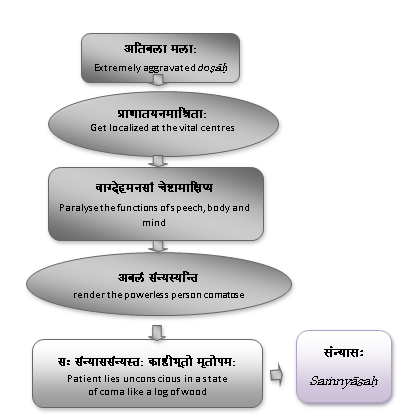
87. सन्निरुद्धगुदः (Sanniruddhagudaḥ)
The text
वेगसन्धारणाद्वायुर्विहतो गुदसंश्रितः। निरुणद्धि महास्रोतः सूक्ष्मद्वारं करोति च॥
मार्गस्य सौक्ष्म्यात् कृच्छ्रेण पुरीषं तस्य गच्छति। सन्निरुद्धगुदं व्याधिमेतं विद्यात् सुदारुणम्॥
(क्षुद्ररोग-निदानम् ४८-४९)
Easy Sanskrit meaning (anvaya)-
वेगसंधारणात् विहत: वायु: गुदसंश्रितः महास्रोतः निरुणद्धि सूक्ष्मद्वारं च करोति। तस्य मार्गस्य सौक्ष्म्यात् पुरीषं कृच्छ्रेण गच्छति। एतं सुदारुणं व्याधिं सन्निरुद्धगुदं विद्यात् ।
English meaning : Vitiated vāyu, located in the anorectal canaldue to the suppression of the urge of defaecation, obstructs the large bowel and narrows the anal opening. On account of the narrowing of the passage the patient passes faeces with great difficulty. This extremely painful condition is known as sanniruddhagudaḥ.
Flow chart-
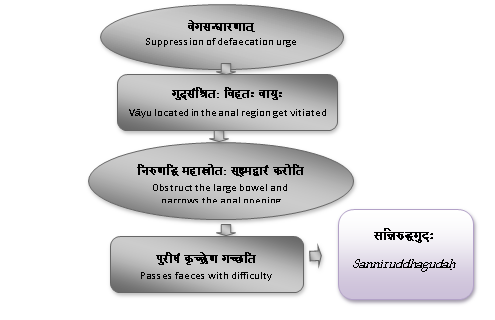
88. सिराजग्रन्थिः (Sirājagranthiḥ)
The text
व्यायामजातैरबलस्य तैस्तैराक्षिप्य वायुस्तु सिराप्रतानम्।
सङ्कुच्य संपीड्य विशोष्य चापि ग्रन्थिं करोत्युन्नतमाशु वृत्तम्॥१६॥
ग्रन्थिः सिराजः स तु ........... (गलगण्डगण्डमालाऽपचीग्रन्थ्यर्बुद-निदानम् १६-१७)
Easy Sanskrit meaning (anvaya)-
तै: तै: व्यायामजातै: अबलस्य वायु: तु सिराप्रतानम् आक्षिप्य संकुच्य, संपीड्य विशोष्य च अपि उन्नतं वृत्तं च ग्रन्थिम् आशु करोति, स: सिराज: ग्रन्थि: ( इति कथ्यते),
English meaning :
Vitiated vāyu, due to various vigorous exercises of weak individuals, afflicts the respective networks of vessels and subsequently compresses, squeezes and dries them and produces a raised and round swelling quickly. This (is called) sirājagranthiḥ.
Flow chart-
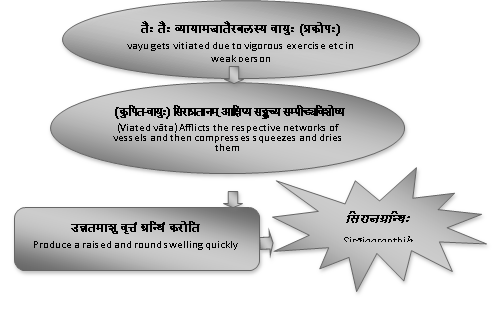
89. स्तनरोगः (Stanarōgaḥ)
The text
सक्षीरौ वाऽप्यदुग्धौ वा प्राप्य दोषः स्तनौ स्त्रियाः।
प्रदूष्य मांस-रुधिरं स्तनरोगाय कल्पते॥ (स्तनरोग-निदानम् १)
Easy Sanskrit meaning (anvaya)-
स्त्रियाः सक्षीरौ अदुग्धौ वा स्तनौ: दोषः प्राप्य मांसरुधिरं वा प्रदूष्य स्तनरोगाय कल्पते।
English meaning : The vitiated doṣa reaching the breasts of lacta-
ting or non-lactating women and afflicting the māṁsa and rudhira (the soft tissues
and blood) produces diseases of the breast.
Flow chart-
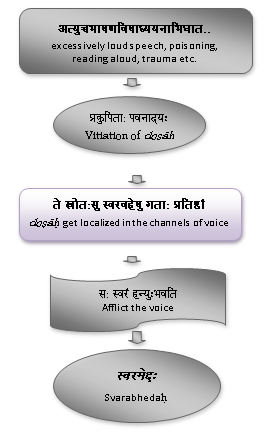
90.स्वरभेदः (Svarabhēdaḥ)
The text
अत्युच्चभाषण-विषाध्ययनाभिघात-संदूषणैः प्रकुपिताः पवनादयस्तु।
स्रोतःसु ते स्वरवहेषु गताः प्रतिष्ठां हन्युः स्वरं भवति चापि हि षड्विधः सः॥
(स्वरभेद -निदानम्/२ )
Easy Sanskrit meaning (anvaya)-
अत्युच्चभाषणविषाध्ययनाभिघात-संदूषणैः प्रकुपिताः पवनादय: तु ते स्वरवहेषु स्रोतःसु प्रतिष्टां गता:।स: स्वरं हन्युःभवति।
English meaning :
Vāyu and other doṣa aggravated by excessively loud speech, poisoning, reading aloud, trauma and other vitiating factors get localized in the svaravaha-srota (channels of voice) and afflict the voice.
Flow chart-

91.हनुग्रहः (Hanugrahaḥ)
The text
जिह्वानिर्लेखनाच्छुष्क-भक्षणादभिघाततः। कुपितो हनुमूलस्थः स्रंसयित्वाऽनिलो हनुम्॥
करोति विवृतास्यत्वमथवा संवृतास्यताम्। हनुग्रहः स तेन स्यात् कृच्छ्राच्चर्वणभाषणम्॥
(वातव्याधि-निदानम्/४९-५० )
Easy Sanskrit meaning (anvaya)- जिह्वानिर्लेखनात् शुष्कभक्षणात् अभिघाततः च हनुमूलस्थः कुपित: अनिल: हनुं स्रंसयित्वा विवृतास्यत्वम् अथवासंवृतास्यतां करोति, स: हनुग्रहः(कथ्यते), चर्वणभाषणं कृच्छ्रात् स्यात् ।
English meaning :
On account of scraping the tongue (improperly) or eating dry (hard) food and due to trauma vāyu, situated at the hanumūla (joint of the jaw), becomes vitiated and dislocates the hanu (jaw) causing it remain open or closed. The condition is known as hanugrahaḥ and it produces inability to masticate and speak.
Flow chart-
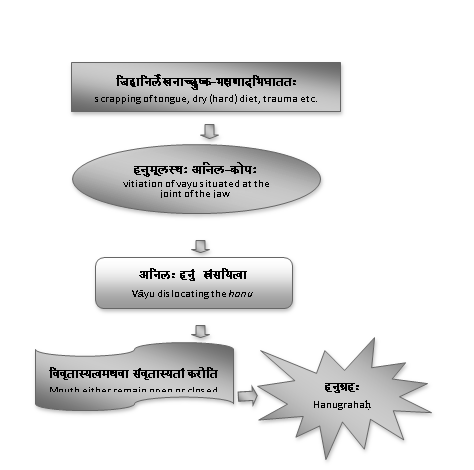
92.हृद्रोगः (Hṛdrogaḥ)
The text
दूषयित्वा रसं दोषा विगुणा हृदयं गताः। हृदि बाधां प्रकुर्वन्ति हृद्रोगं तं प्रचक्षते॥(हृद्रोग- निदानम् १)
Easy Sanskrit meaning - विगुणा: दोषा: रसं दूषयित्वा हृदयं गताः हृदि बाधां प्रकुर्वन्ति, तं हृद्रोगं प्रचक्षते।
English meaning : Vitiated (by their aetiological factors) doṣa, affecting the rasa and reaching the heart, impairs its functions; the condition is known as the hṛdroga.
Flow chart-
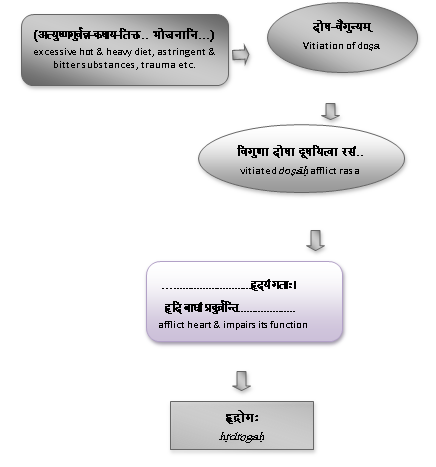
[1] Not adequately examplain as sampr¡pti.
[2] Stepwise sampr¡pti is not mentioned
[3] Please refer samprāpti chart no 8
